Photography Midterm
1/96
Earn XP
Description and Tags
Photo and Quote Identification
Name | Mastery | Learn | Test | Matching | Spaced |
|---|
No study sessions yet.
97 Terms
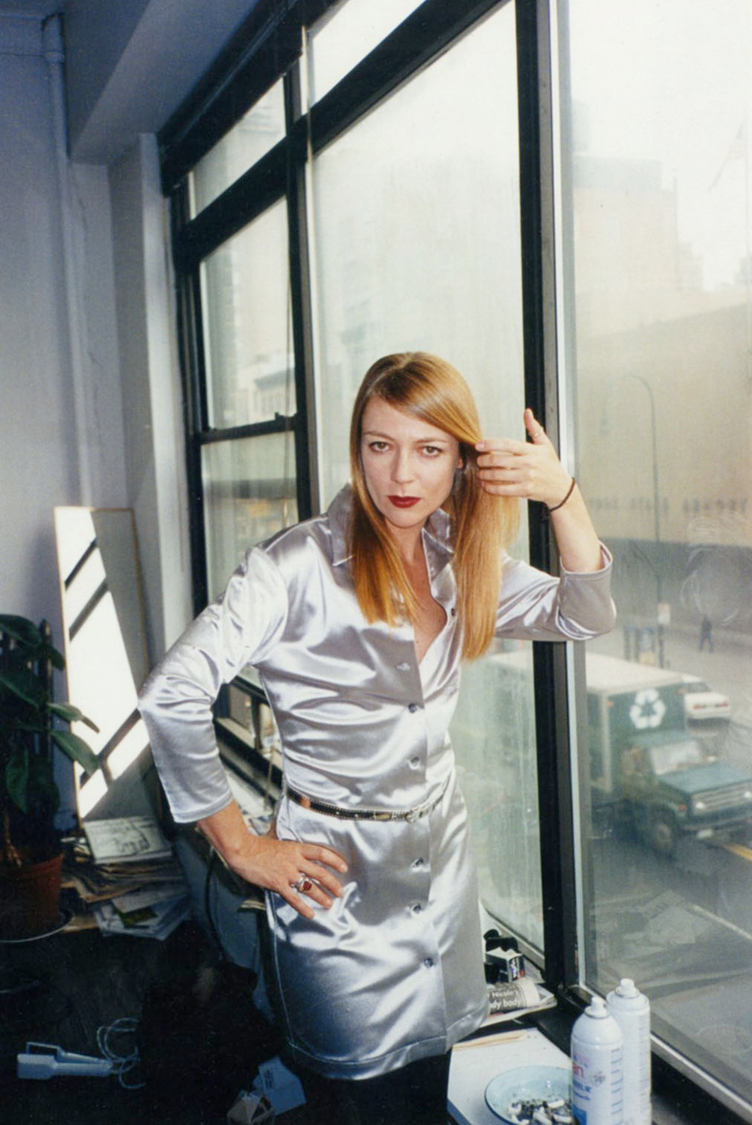
Provide photographer, subject, and date
Wolfgang Tillmans, Morwenna Banks (1995)

Please provide context
Morwenna Banks is a British actress. This image was part of the lecture section Reclaiming Selfhood within Image Worlds. The image unravels the idea of presenting yourself perfectly - behind the scenes are the instruments of Banks’s self-staging (hair straightener on floor)
“No one can be unselfconscious of photographs [when they are in front of the camera, or the I-Phone]. There is an encyclopedia of representation that is in our heads almost from the day we were born. I think that my work is … dealing with that … what I really try to do in my work is photograph people in between these two poles: their pure, innocent self and their inescapable knowledge and vision of themselves and of society.” - _________
Wolfgang Tillmans: Part of the lecture section Reclaiming Selfhood within Image Worlds, about portraits - Tillmans focused on portraits, trying to capture the in between, before someone is totally ready and presentable for the camera, to show an unkempt/unfinished side of the subject that is otherwise not often captured in professional photography today
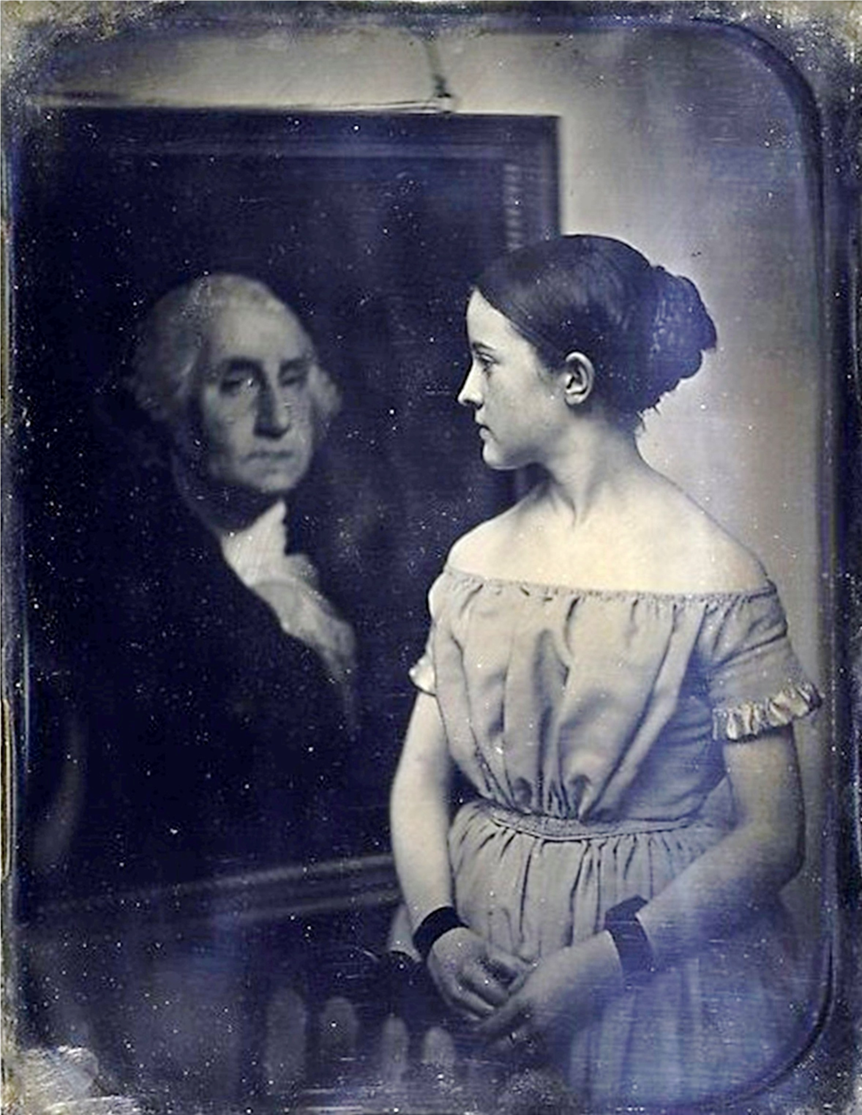
Please provide photographers, title, and date
Albert Sands Southworth and Josiah Johnson Hawes, “Girl with Portrait of George Washington” ca. 1850 (daguerreotype)

Please provide context
This is a daguerreotype, a form of photography on the rise with the middle class, as the daguerreotype became more accessible to working people, women, even enslaved people or freed slaves. Southworth and Hawes were good at making their daguerreotypes graceful and seemingly upstaged despite them being very staged and having long exposure times
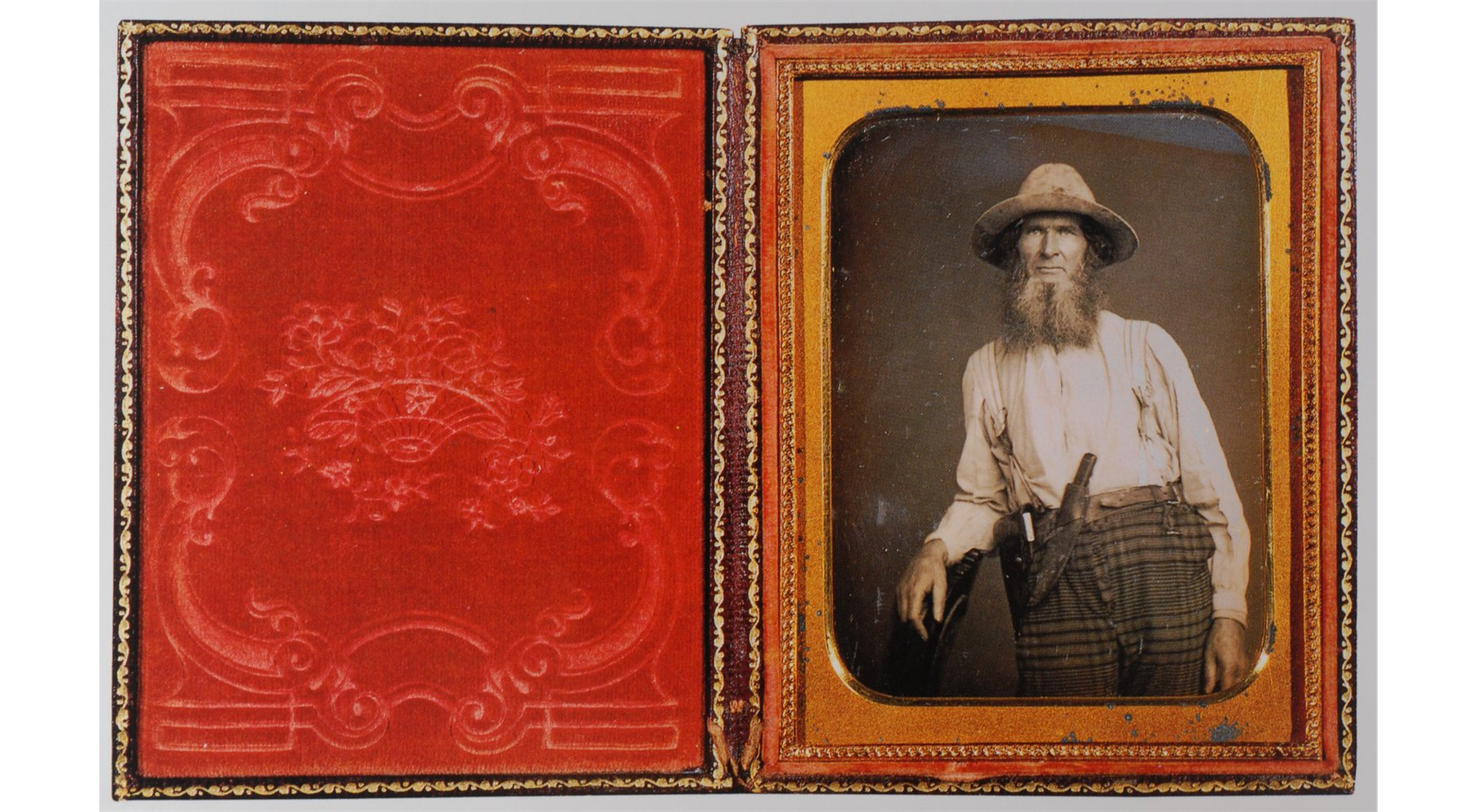
Provide title/subject and date
“California Forty-Niner”, 1850 (daguerreotype)
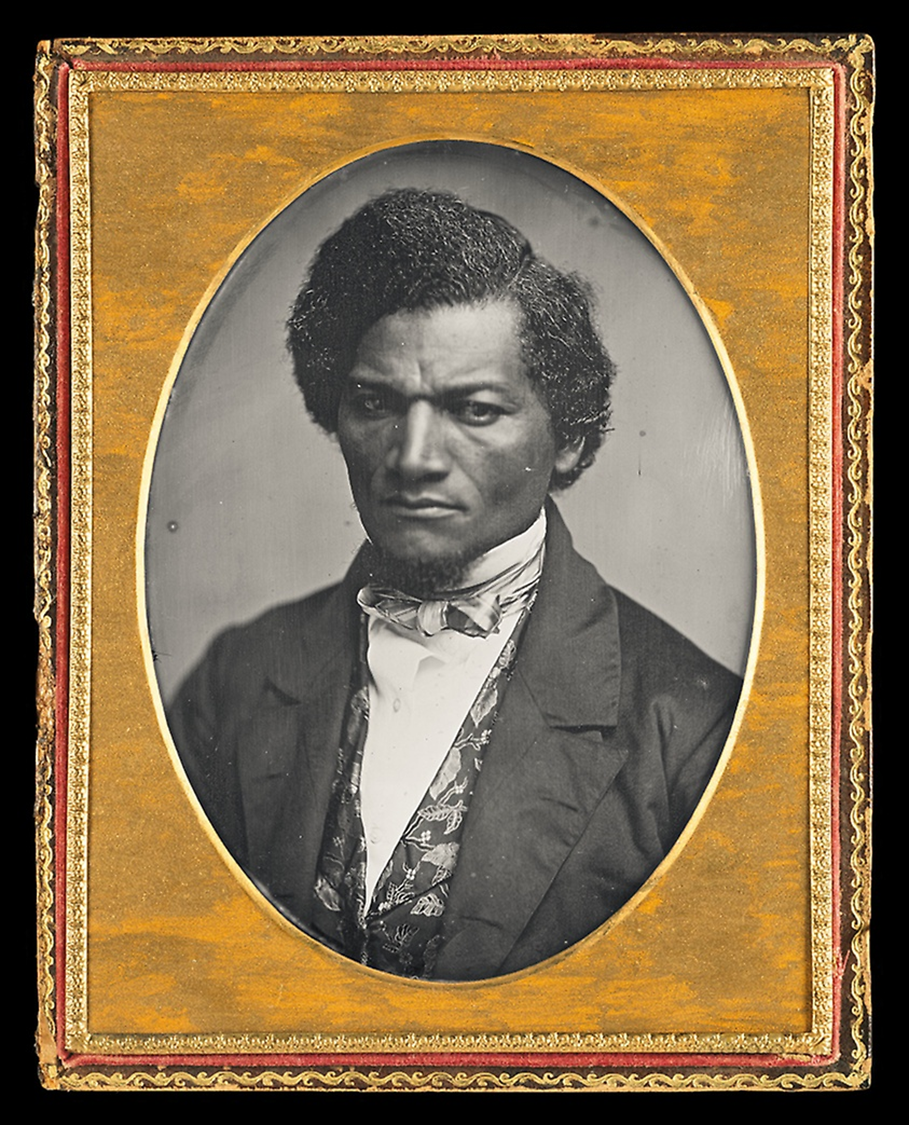
Provide photographer, title/subject, and date
Samuel J. Miller, “Frederick Douglass”, ca. 1817/1818-1895 (daguerreotype)
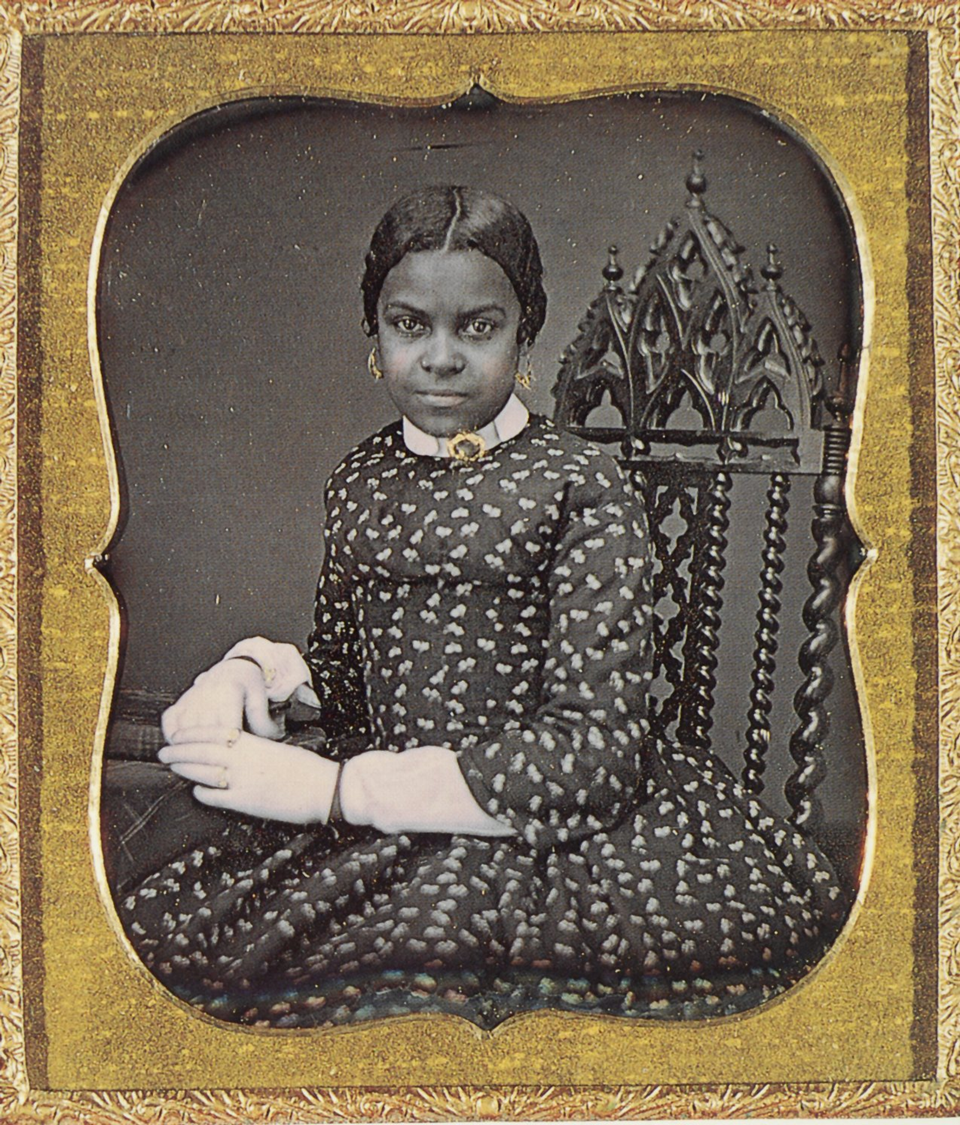
Provide title/subject, date, and location
“Seated Woman with Gloves”, 1855: George Eastman House (daguerreotype)
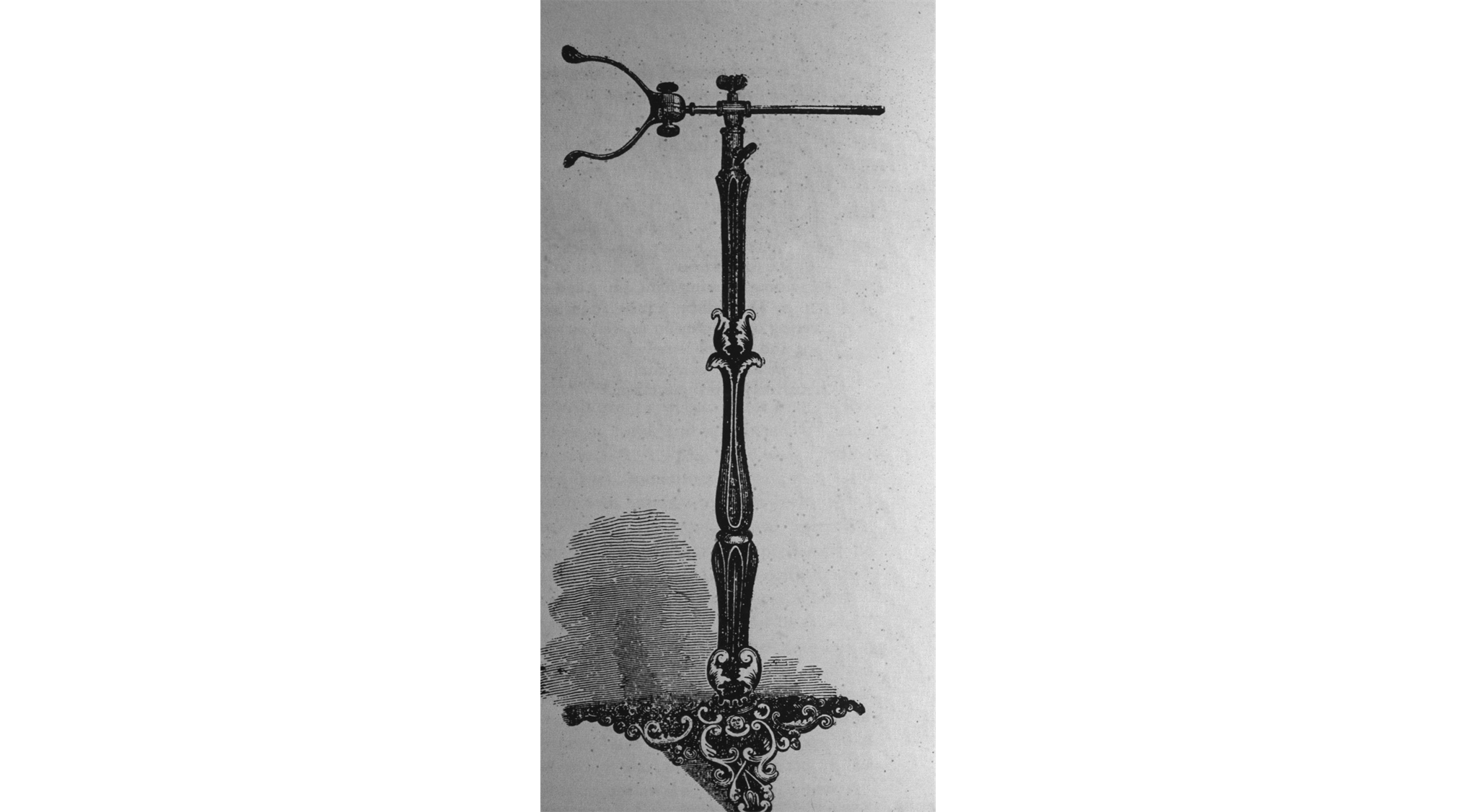
Provide description/context … what is this?
head stand for use in a photographer’s studio —> to keep the subject still during long exposure time
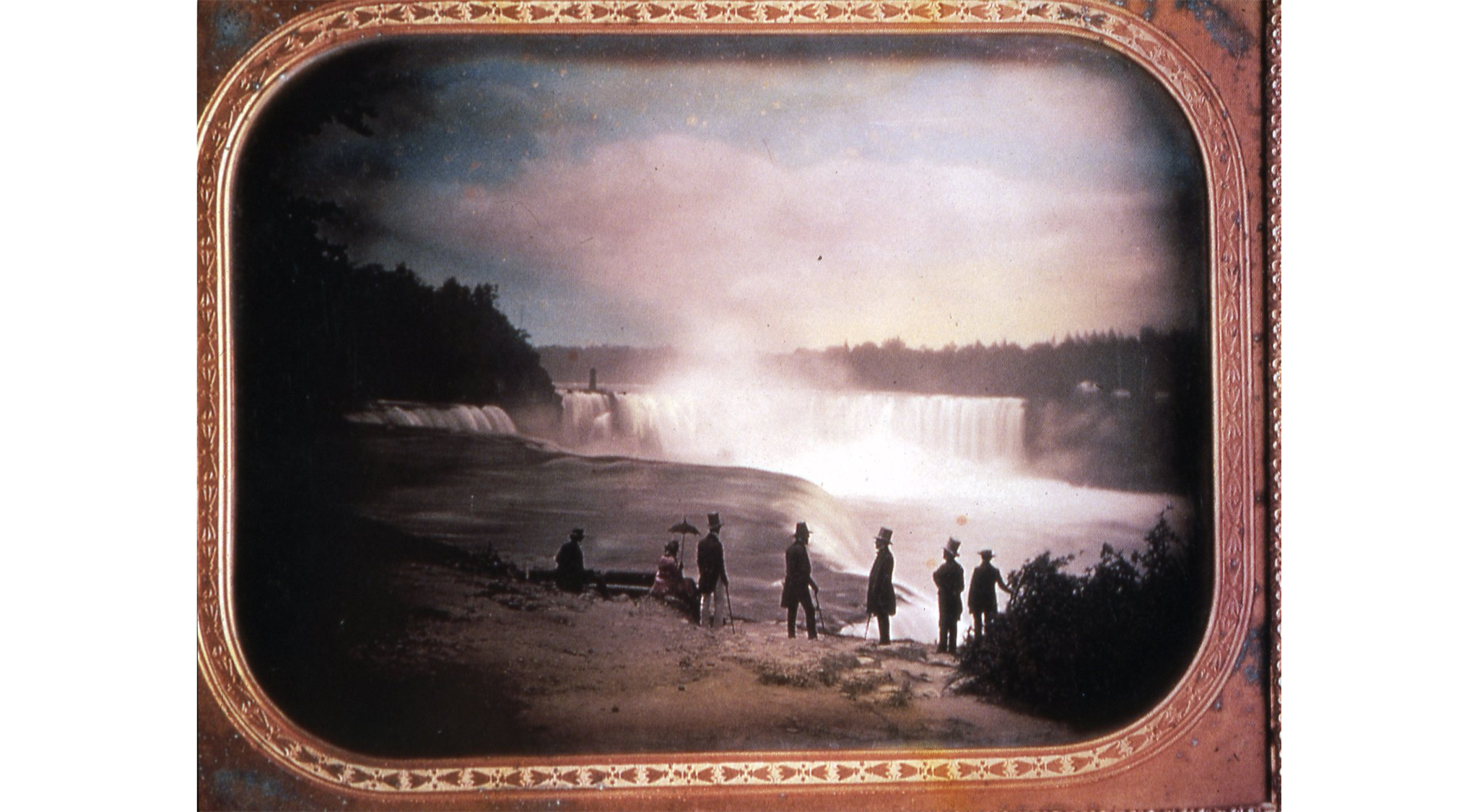
photo info, type, and context
anonymous, no time but is a daguerreotype, so I’d estimate ca 1850, we discussed in class that this photo looks so natural and casual and like it captures a split moment in time, but actually it is very staged with a long exposure time
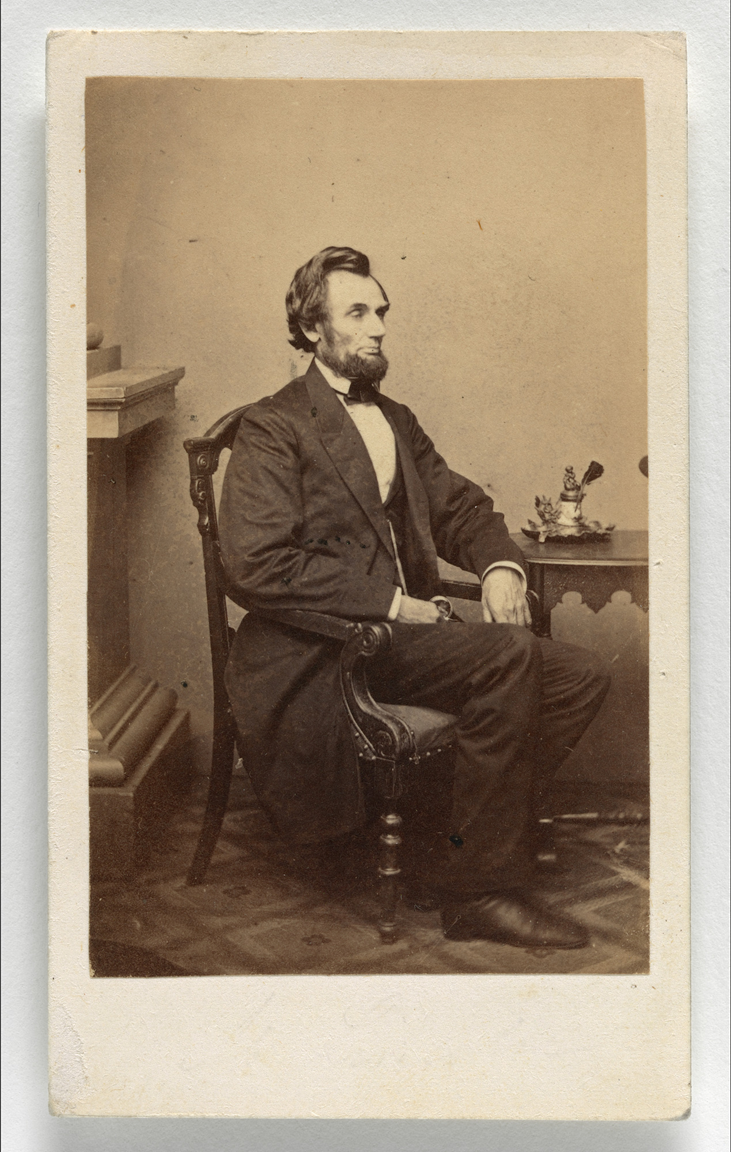
Provide studio/photographer, title/subject, and date
studio of Matthew Brady, Seated Portrait of Lincoln, 1861: albumen print
“The pure, the high, the noble traits beaming from these faces and forms, — … who shall measure the greatness of their effect on the impressionable minds of those who catch sight of them at every turn? - ___________
Marcus Aurelius Root (1864): From Photography, Nationhood, Public Selfhood and Celebrity lecture slides. The lecture slides pair this quote with a photo of Lincoln. Root is referring to the concept of the ILLUSTRIOUS MAN - pride, ready to serve the nation, etc., which was key context to the Civil War
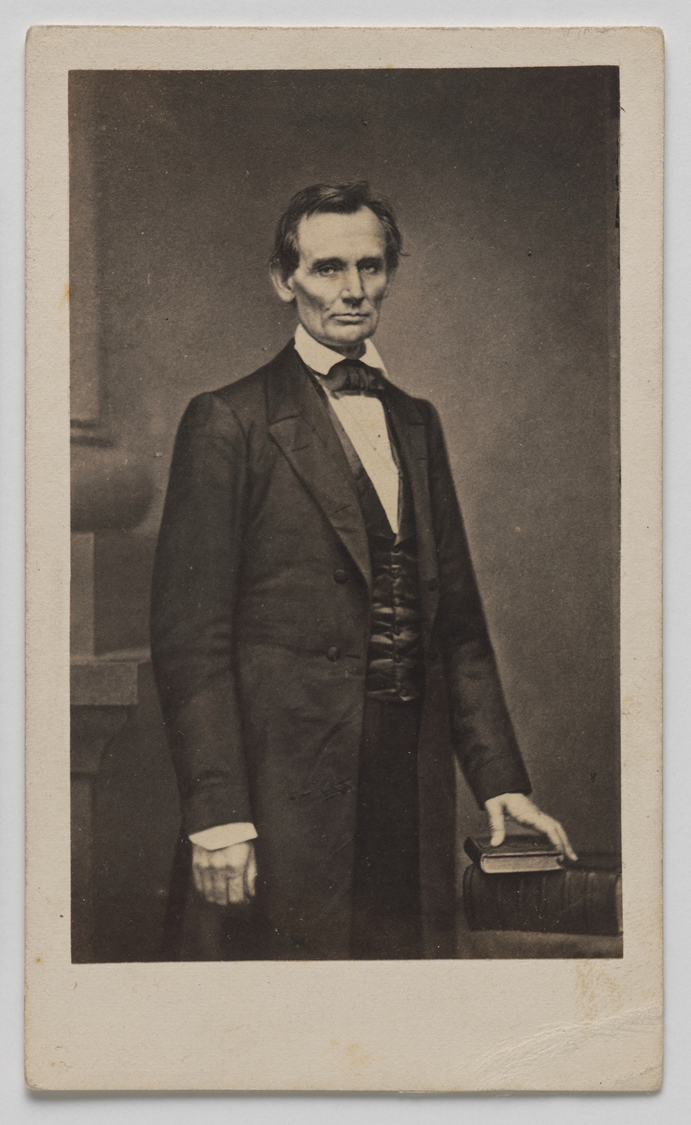
Provide photographer, title/subject, year
Matthew Brady, “Abraham Lincoln,” 1860 (taken at Brady’s Broadway studio prior to Lincoln’s presidential launch)
“Brady and the Cooper Union speech made me President of the United States.” - ______
Abraham Lincoln: He gave credit to Matthew Brady’s photography work for putting his image as an illustrious man out into the public
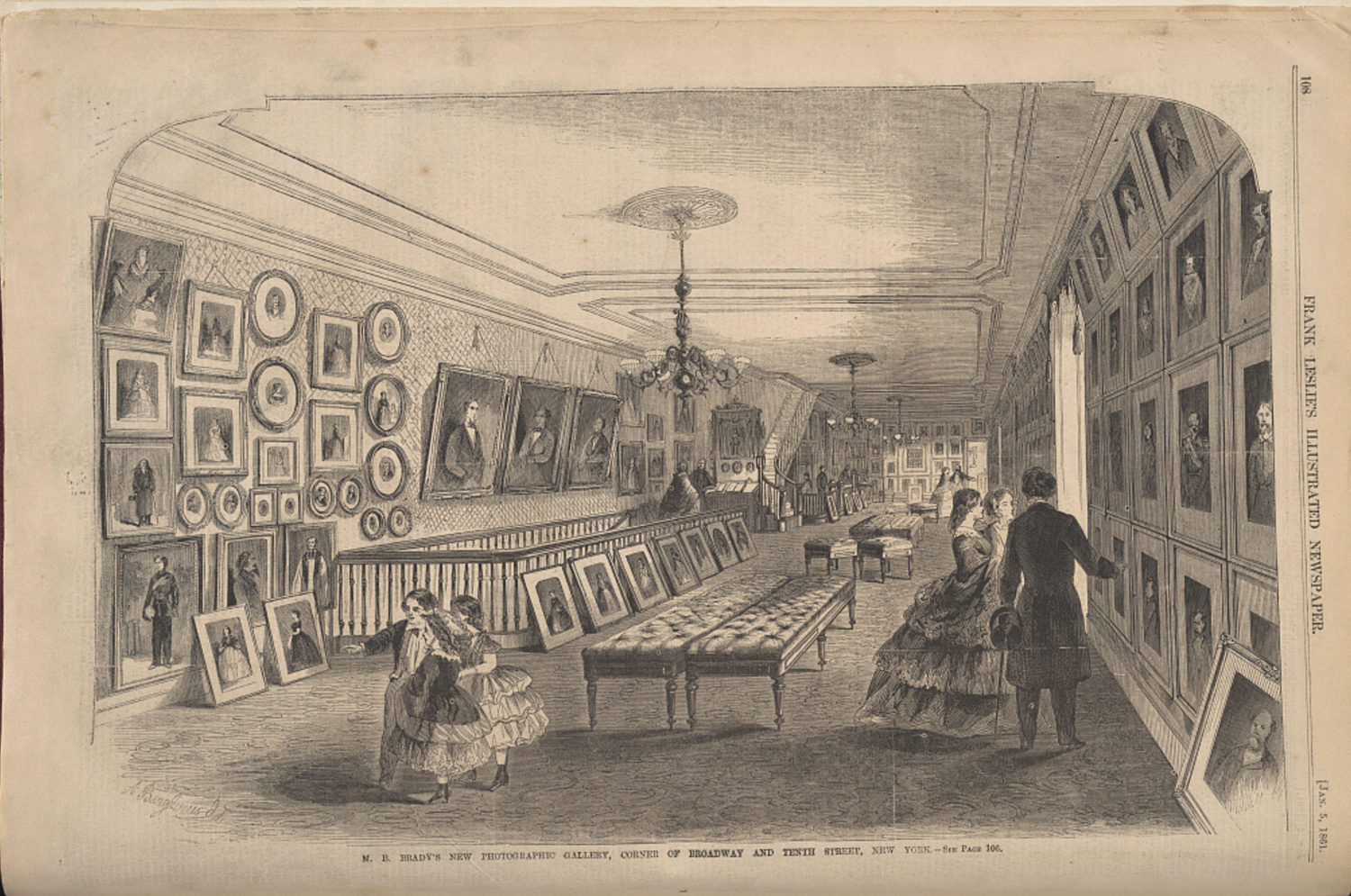
Provide subject and location
Matthew Brady’s New Photographic Gallery, Broadway and Tenth Street, NYC —> the sutdio brought people together to view photography in a time at the brink of the Civil War, where there were likely different viewpoints in one room
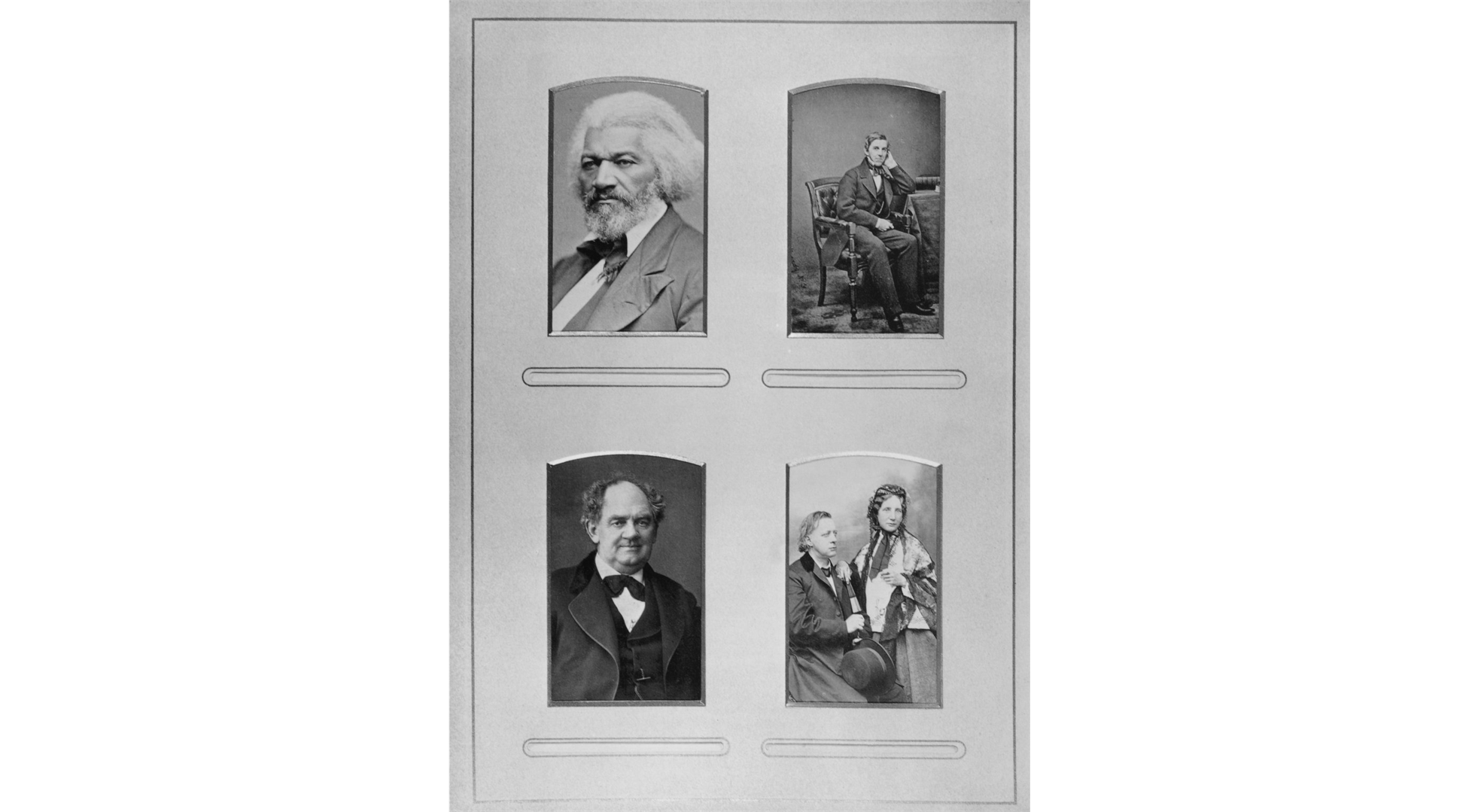
Provide photo type and subjects captured
album page with cartes de visites of famous people: Frederick Douglass, P.T. Barnum, and Reverend Henry Ward Beecher and wife
significance: this photo starts blurring the lines between illustrious men and celebrities. For example, it seems an interesting choice to place Frederick Douglass net to P.T. Barnum
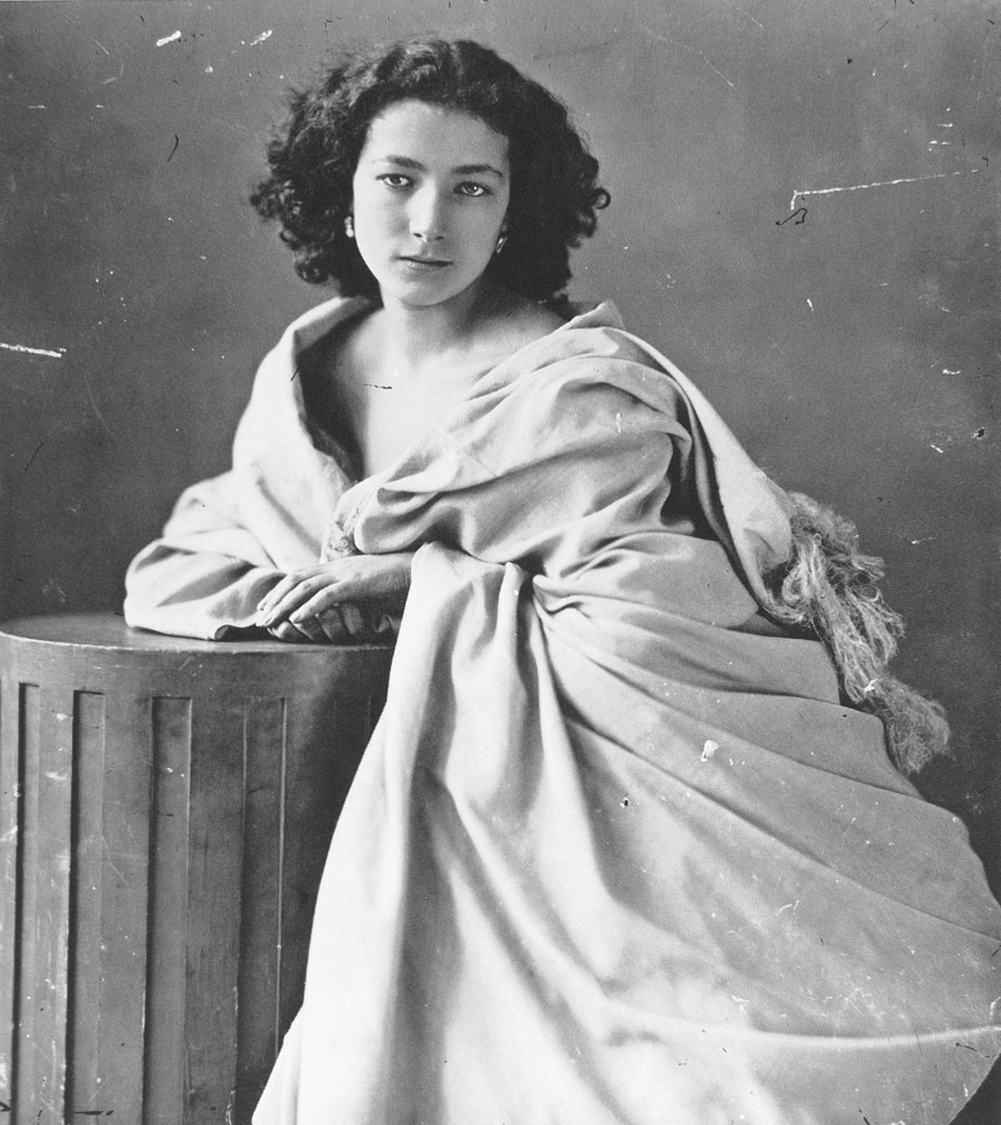
Provide photographer, subject, photo type and date
Nadar (French), Sarah Bernhardt (French actress), wet collodion, 1860-1865
significance: very different presentation of a woman (desired/desirable, seductive gaze, half smile, leanings towards us which is inviting) compared to Lincoln the illustrious man
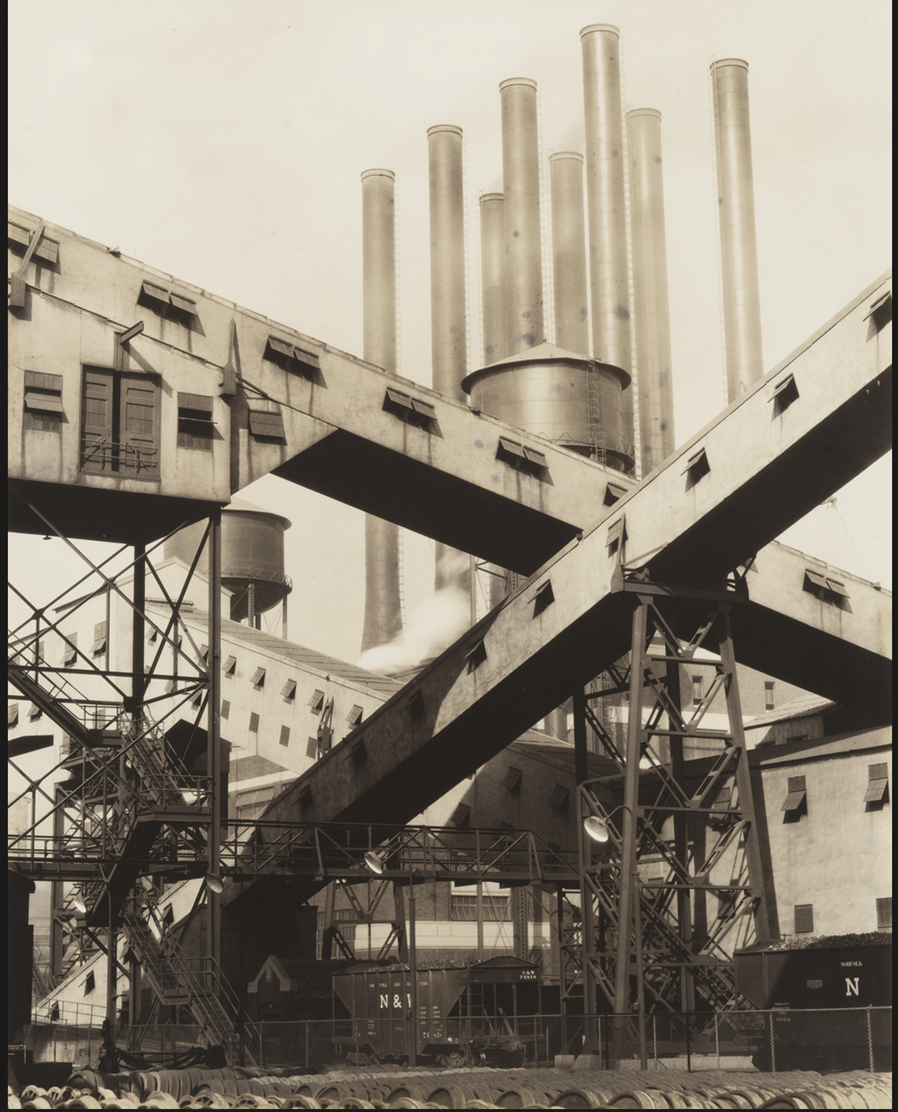
Provide photographer, title/subject, location, date
Charles Sheeler, “Criss-Crossed Conveyors,” River Rouge Plant, Ford Motor Company, 1927
significance: this was one of the photo options to analyze for our first flex check
Provide photo description and significance
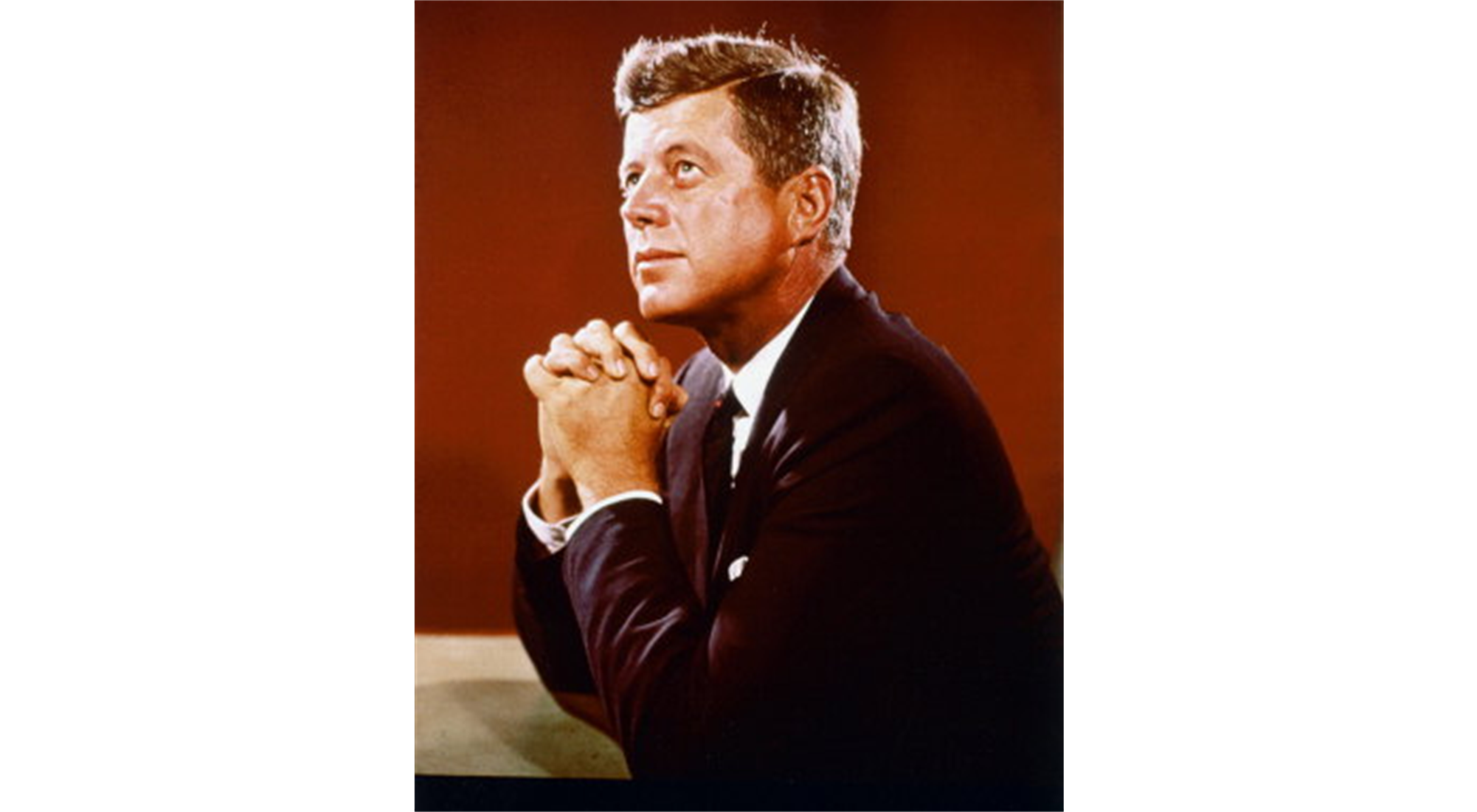
press photograph of John F. Kennedy praying: Demonstrates the role of pose, lighting, and framing in creating connotative meaning
reference to the connotative and second meaning that Ronald Barthes discusses in his “Message without a Code” (1977)
Signification as the process whereby “‘the unculture of a mechanical art [is transformed] into the most social of institutions.’ - __________
Ronald Barthes, “Message Without a Code” (1977) —> his argument is that the even the most mechanical aspects of a photograph can be analyzed in a social and interactive and connotative meaning manner
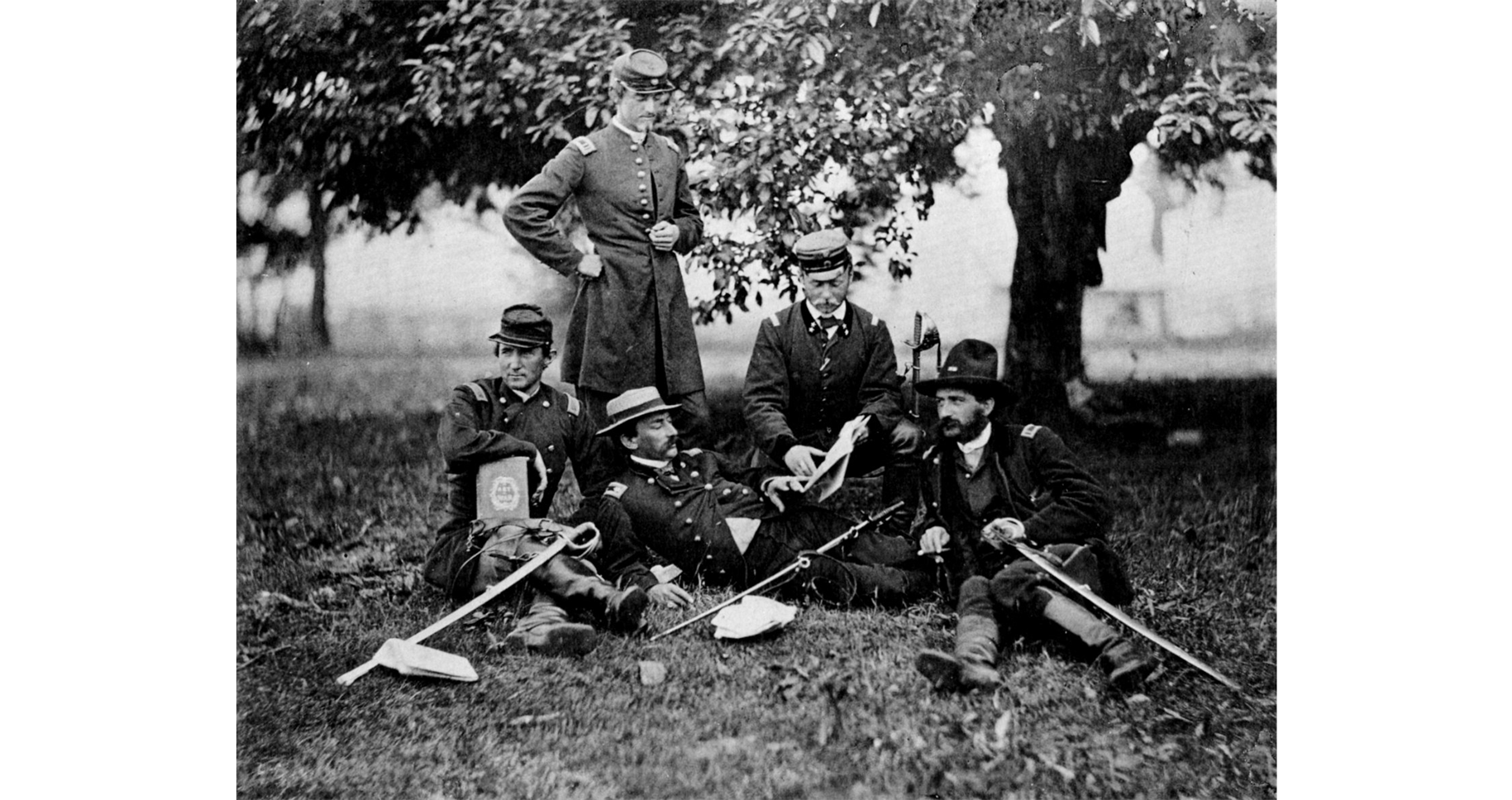
Provide title/subject, location, date
“Studying the Art of War, Fairfax Courthouse, June 1863”
significance/context: part of lecture slides on Alexander Gardner’s Photographic Sketchbook of the Civil War, depicts Union higher-authority soldiers in the Civil War lounging, looking relaxed and possibly strategizing. Gardner worked for Matthew Brady until 1862. The titles of each photograph were created by the publisher, not Gardner, which forces a specific lens on our read of the photographic meaning that may or may not be completely accurate. This photo is very stagged, has aestheticism (aka looks like a painting, certainly not something depicting war)
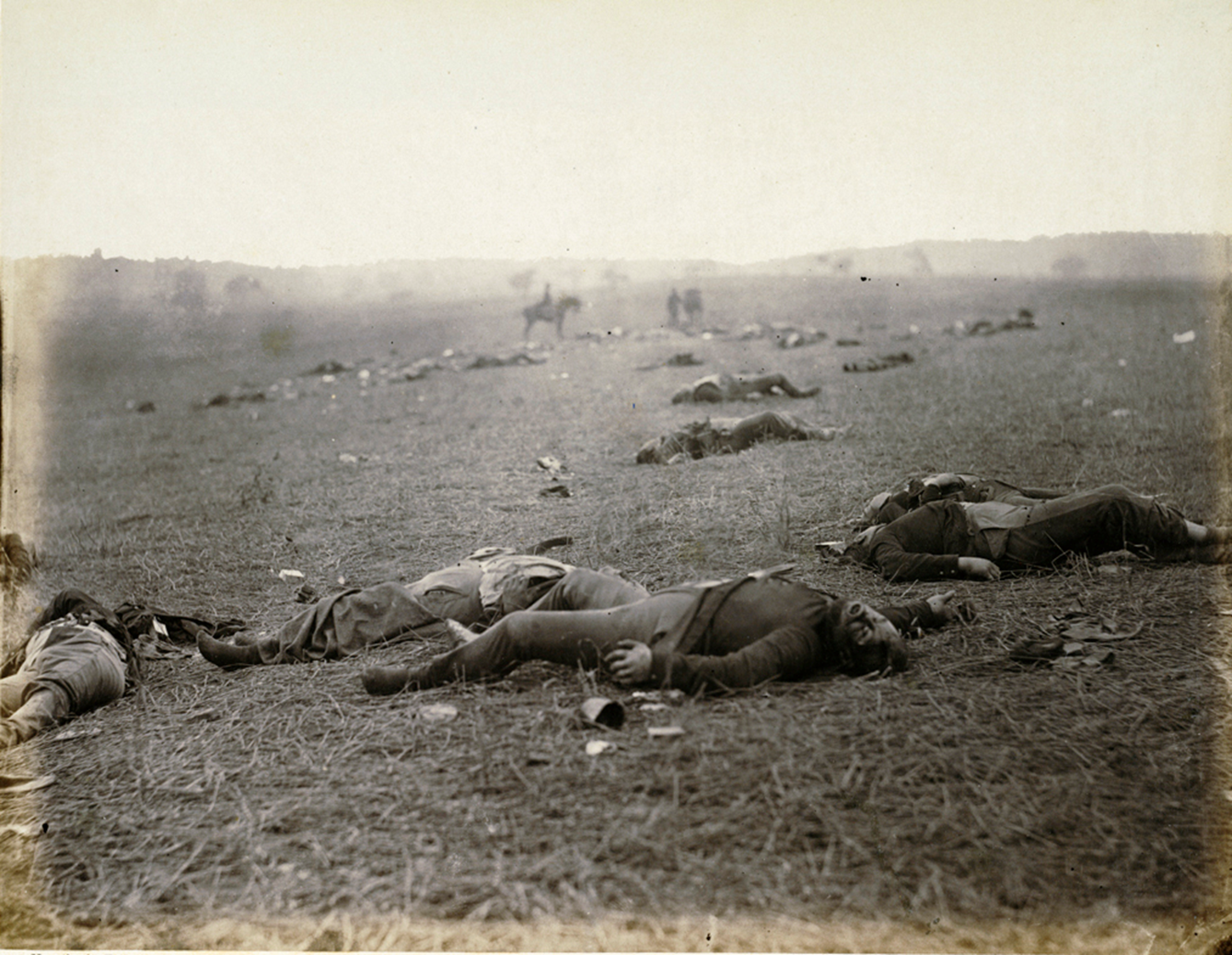
Provide photographer, title/subject, date
Timothy O’Sillivan, “Harvest of Death”, 1865
significance: in Gardner’s Photographic Sketchbook of the Civil War, not posed, the photographer is a spectator within the scene, captures humanness and individuality in only being able to see one face, “Harvest” —> reassurance in the agricultural cycle, that there will be growth again but that death will come again too
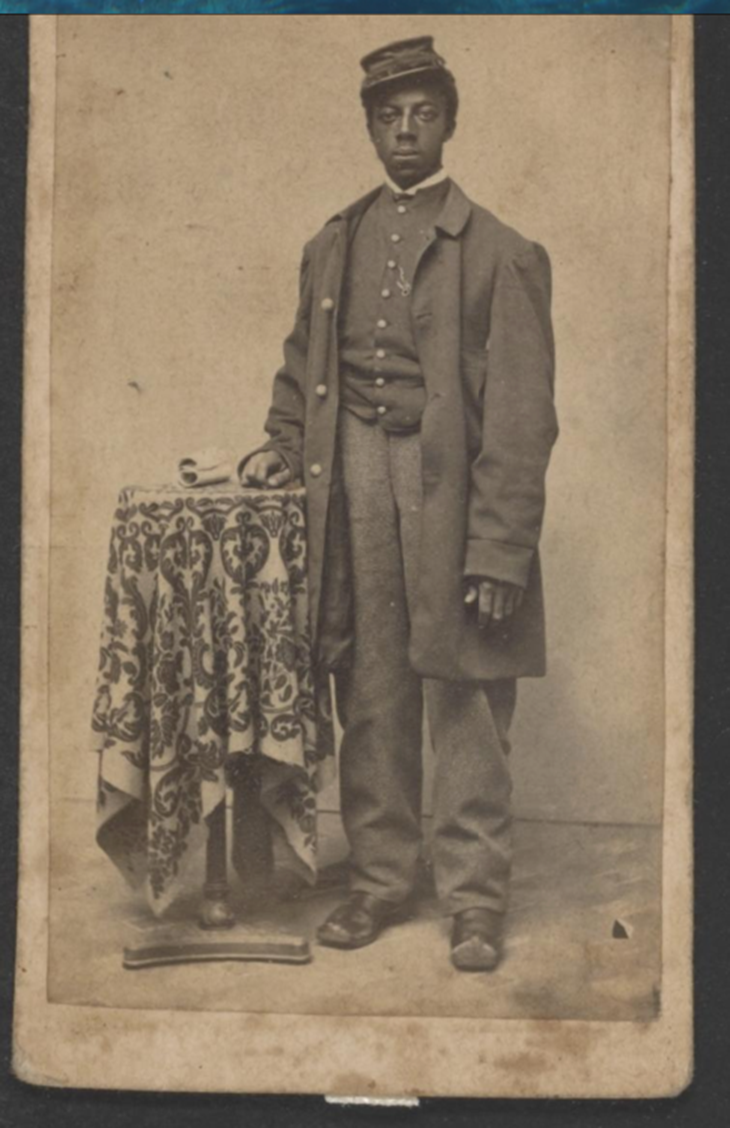
Provide subject, date, collection
Gilbert Montgomery, under-cook, 4th US Cavalry, undated, Civil War, from Wiliama A. Gladstone Afro-American Military Collection
Provide title and date
“A Burial Party, Cold Harbor, Virginia, April 1865”
context: townspeople after this battled refused to pick up and bury the Union soldiers b/c they saw them as enemies, so pickup occurred only at the end of the war, it was a gruesome sight, there was a white overseer figure while black people are the ones cleaning up the bodies (same racial hierarchies in place before and right after the war in this sense)
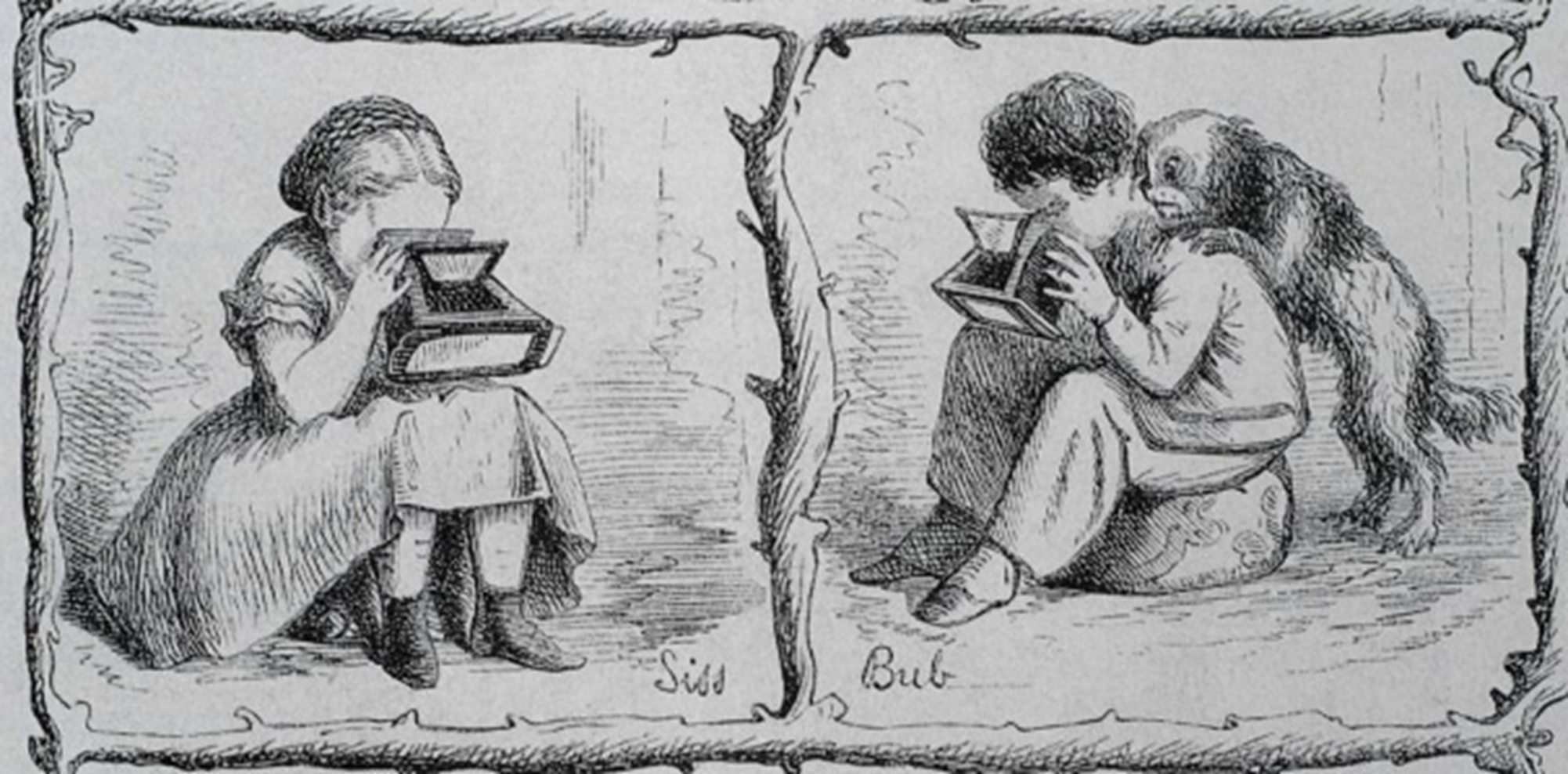
Context
depiction of a brother and sister looking into a stereograph. The stereographic image adds depth, it is like a mask, it had a commercial function and was a viewing experience
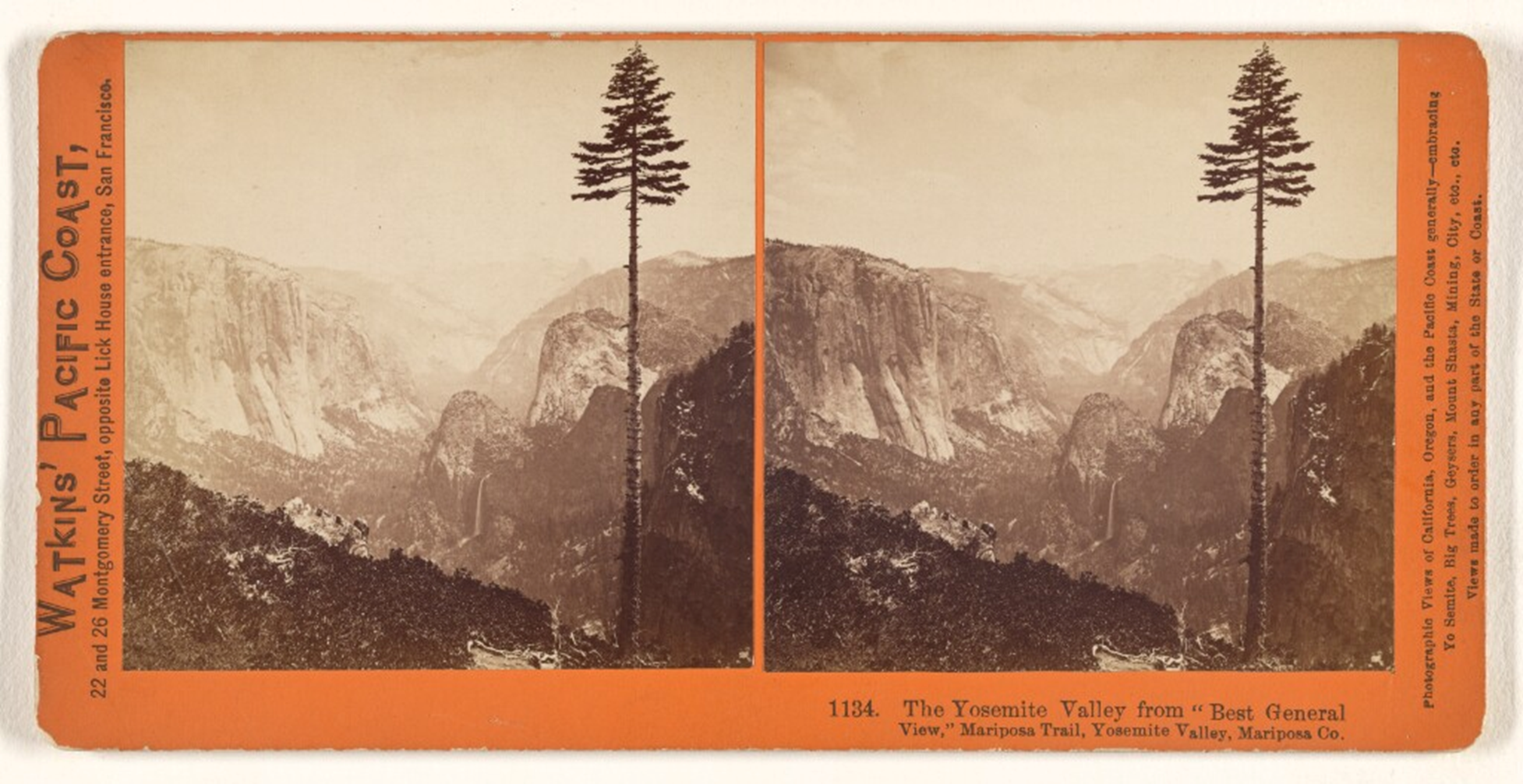
Provide photographer, title and photo type
Carleton Watkins, “Best General View of Yosemite”, stereographic card, undated
context: in lecture about Photographic Surveys of the American West: Photography, Tourism, and the Post-Civil War West (maybe around 1867?)
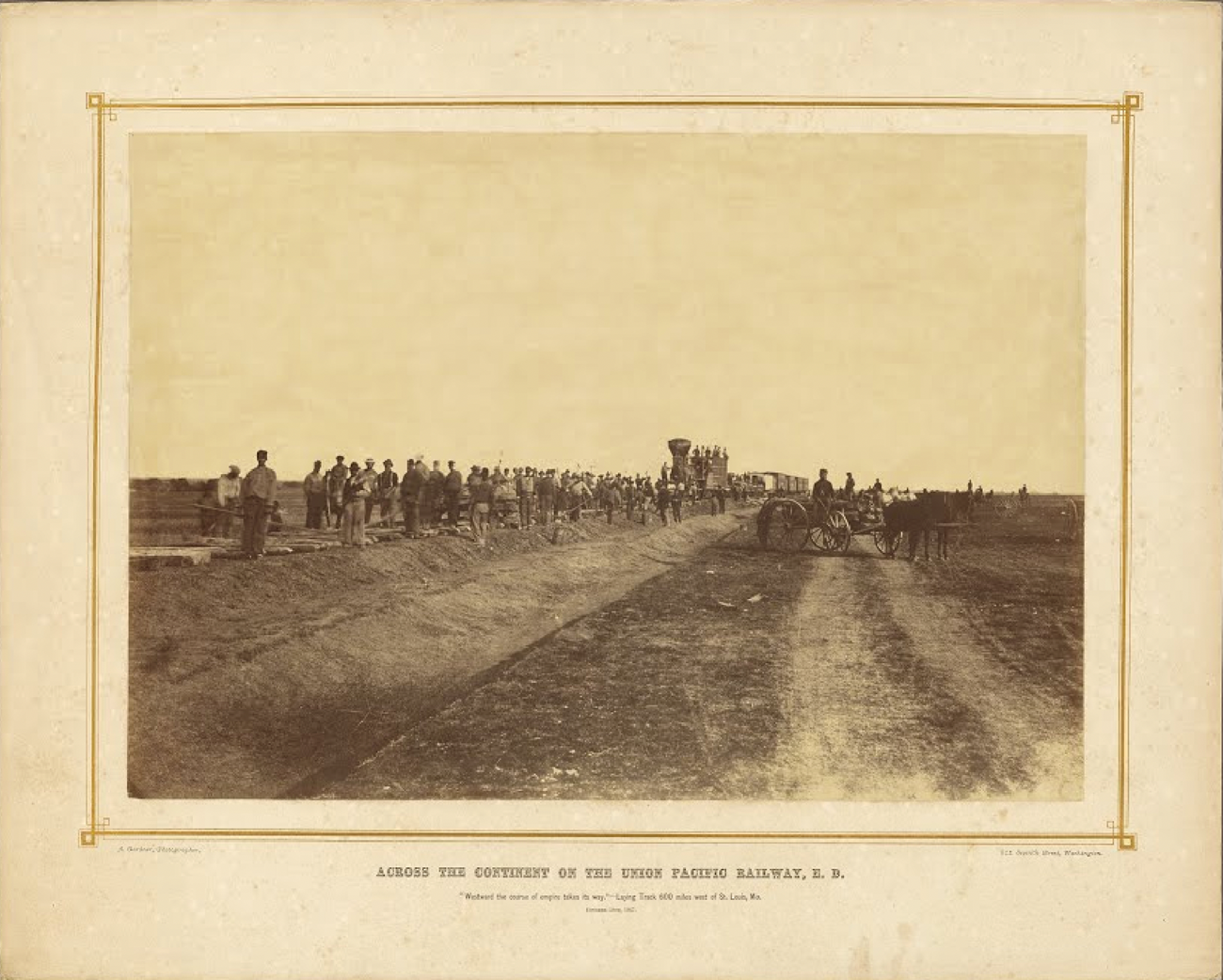
Provide photographer, title, date, photo type
Alexander Gardner, “‘Westward the Course of Empire Takes Its Way.’ Laying track 300 miles west of the Missouri River, 19th Oct. 1867” (albumen print)
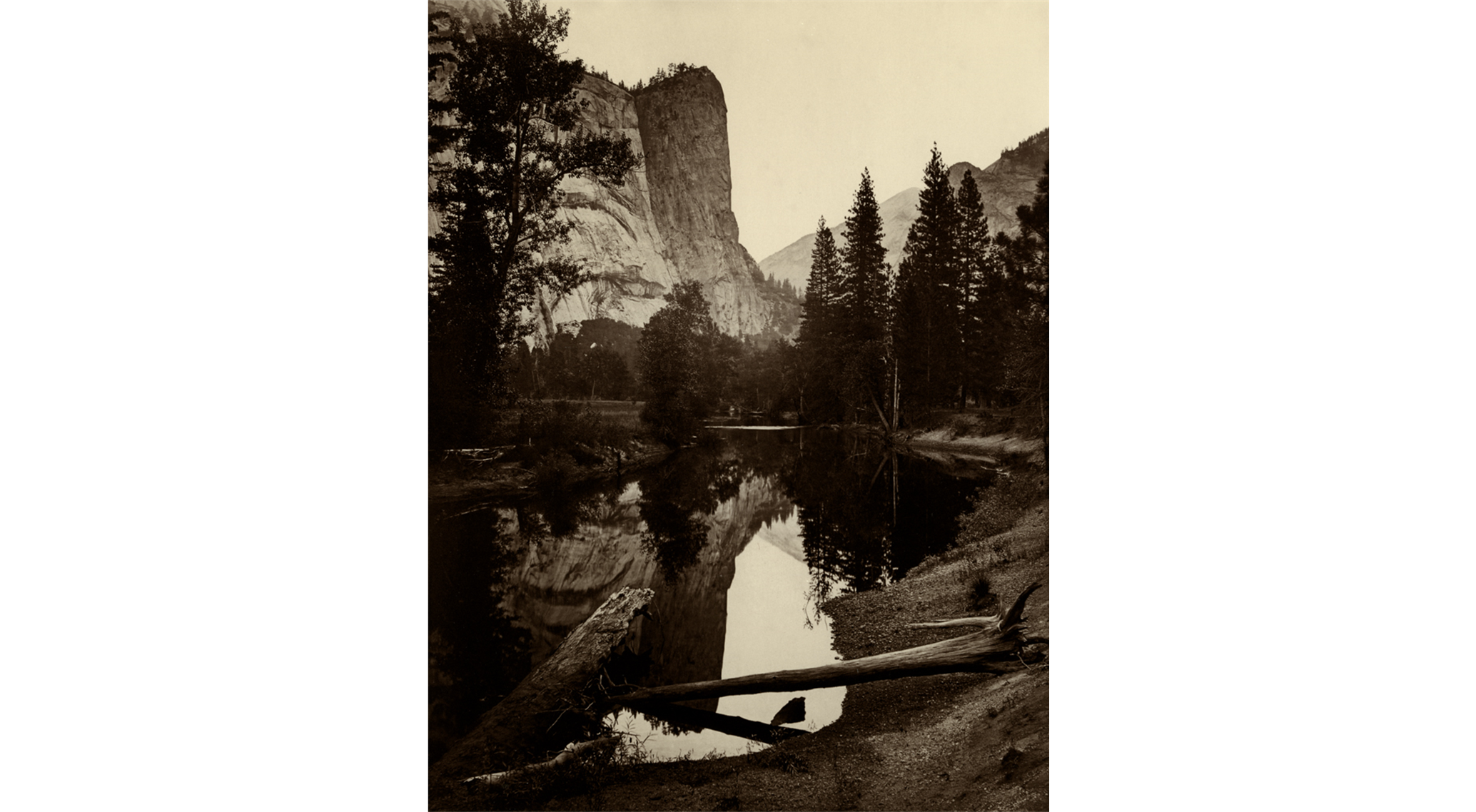
Provide photographer, title, date
Carleton Watkins, “Washington Column, Yosemite Valley (2,052 feet)”, 1872
part of lecture on photographic surveys of the wet and post-civil war west
“the image of a virgin wilderness legitimizes and relieves the images of a ravaged earth …” - _________
Rebecca Solnit
significance: Solnit is describing how untouched and seemingly expansive the American West was at this time and in the way in which this scene was captured
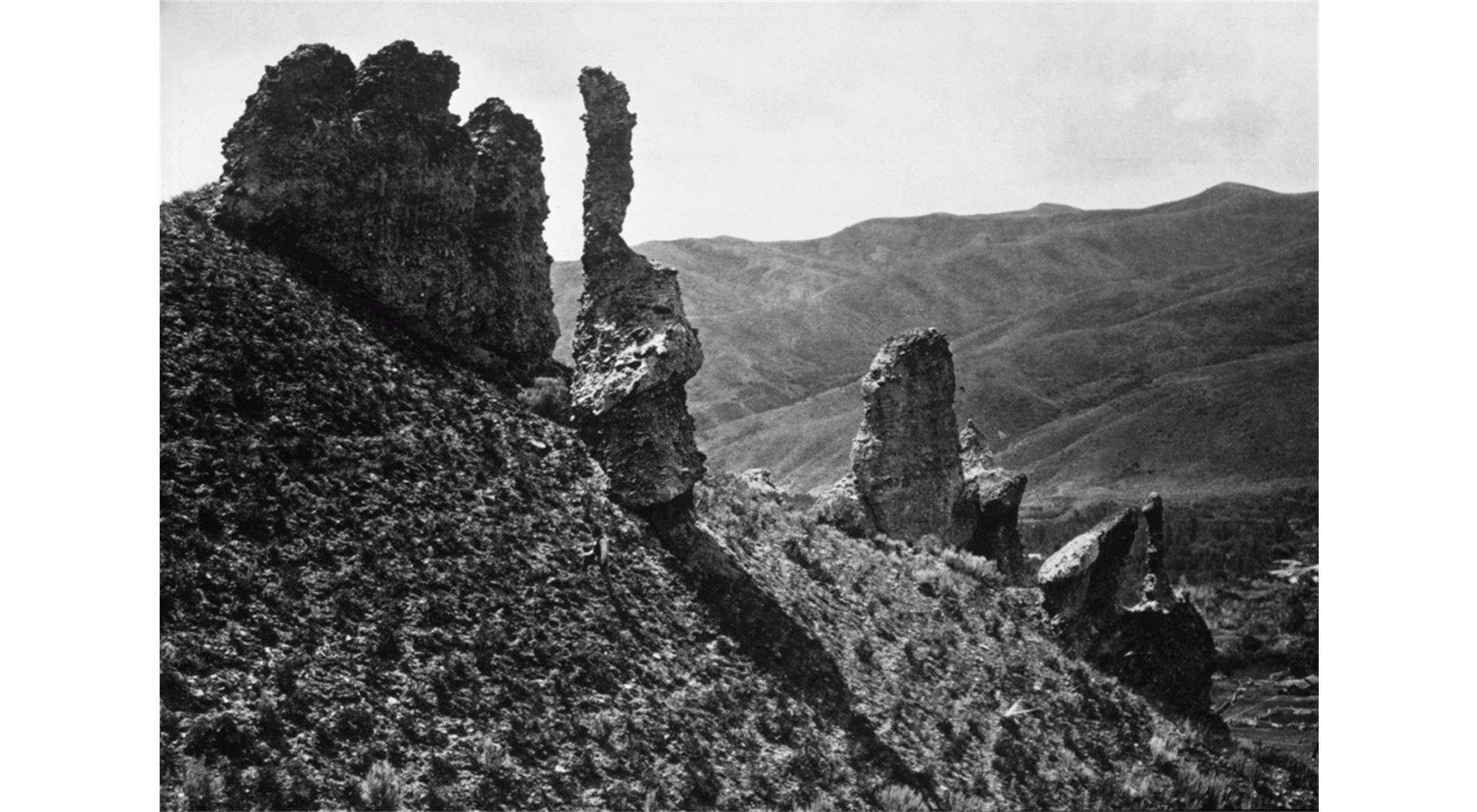
Provide photographer, title, date
Timothy O’Sullivan, “Tertiary Conglomerates, Weber Valley, Utah”, 1869
significance: after photographic the Civil War, he took to surveying the West. O’Sullivan’s photos of the West were very different to those of others —> instead of idealizing and glamorizing the landscape, he was truthful about the harsh environment and character of the West that is resistant to domestication, isolated
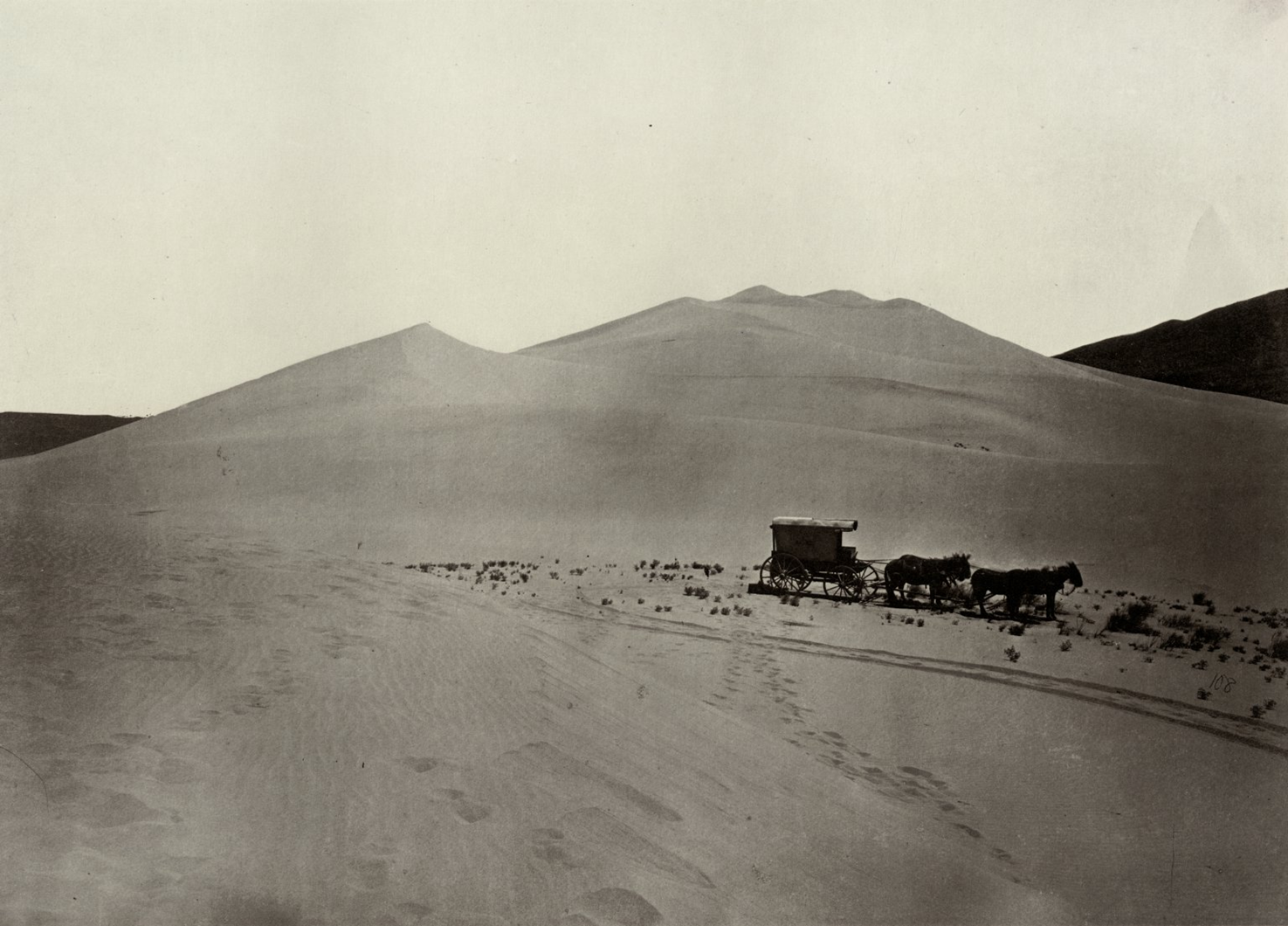
Provide photographer, title, date
Timothy O’Sullivan, “Sand Dunes, Carson Desert, Nevada”, 1867
significance: again showing harsh environment that is the West instead of romanticizing it like some other photographers, shows isolation with footprints in the Sand Dune, the viewer can see exactly how the photographer got to the spot to take the photo
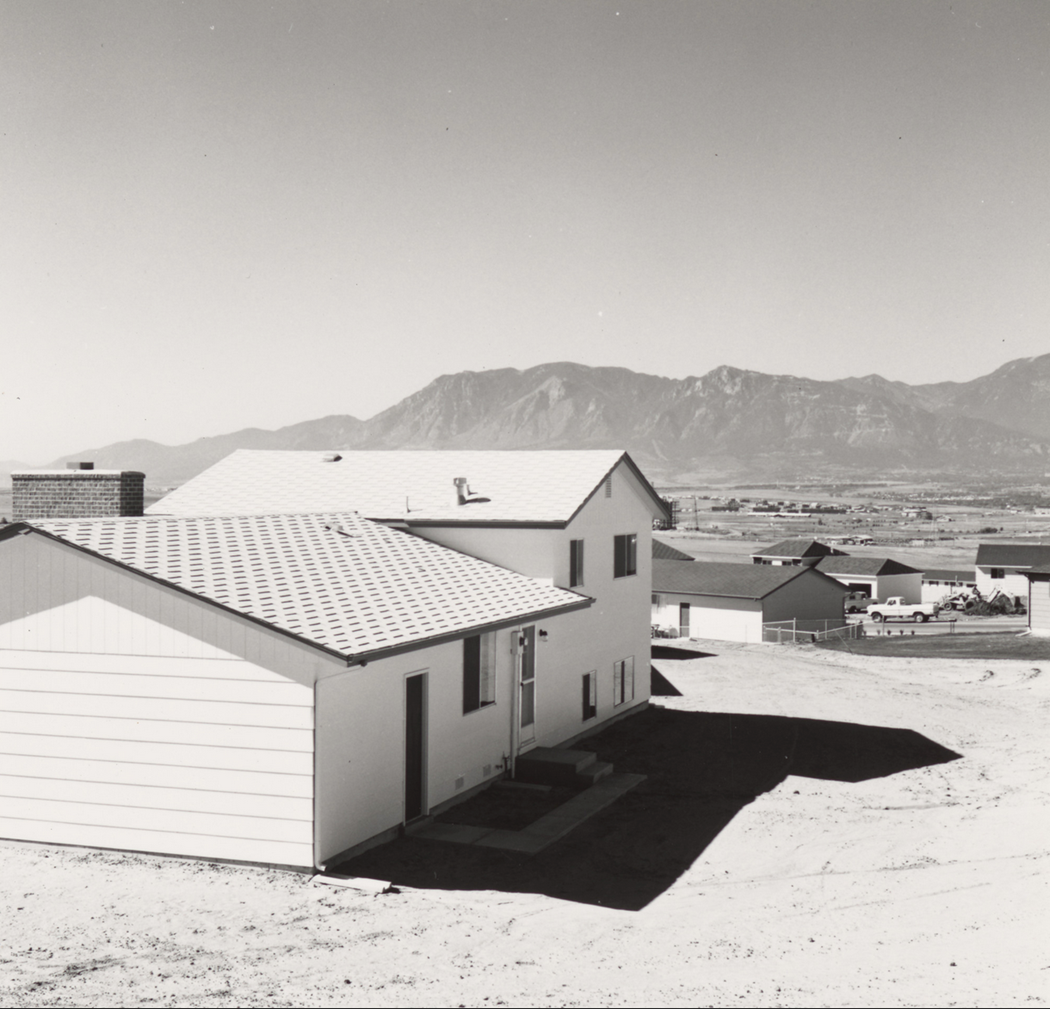
Provide photographer, subject, date
Robert Adams, Newly Completed Tract House, Colorado Springs, 1968
significance: shows how the West has been colonized and settled on drastically compared to 100 years prior, at the height of photographic survey projects on the West (this is my assumption, I can’t find which presentation this photo was discussed in)
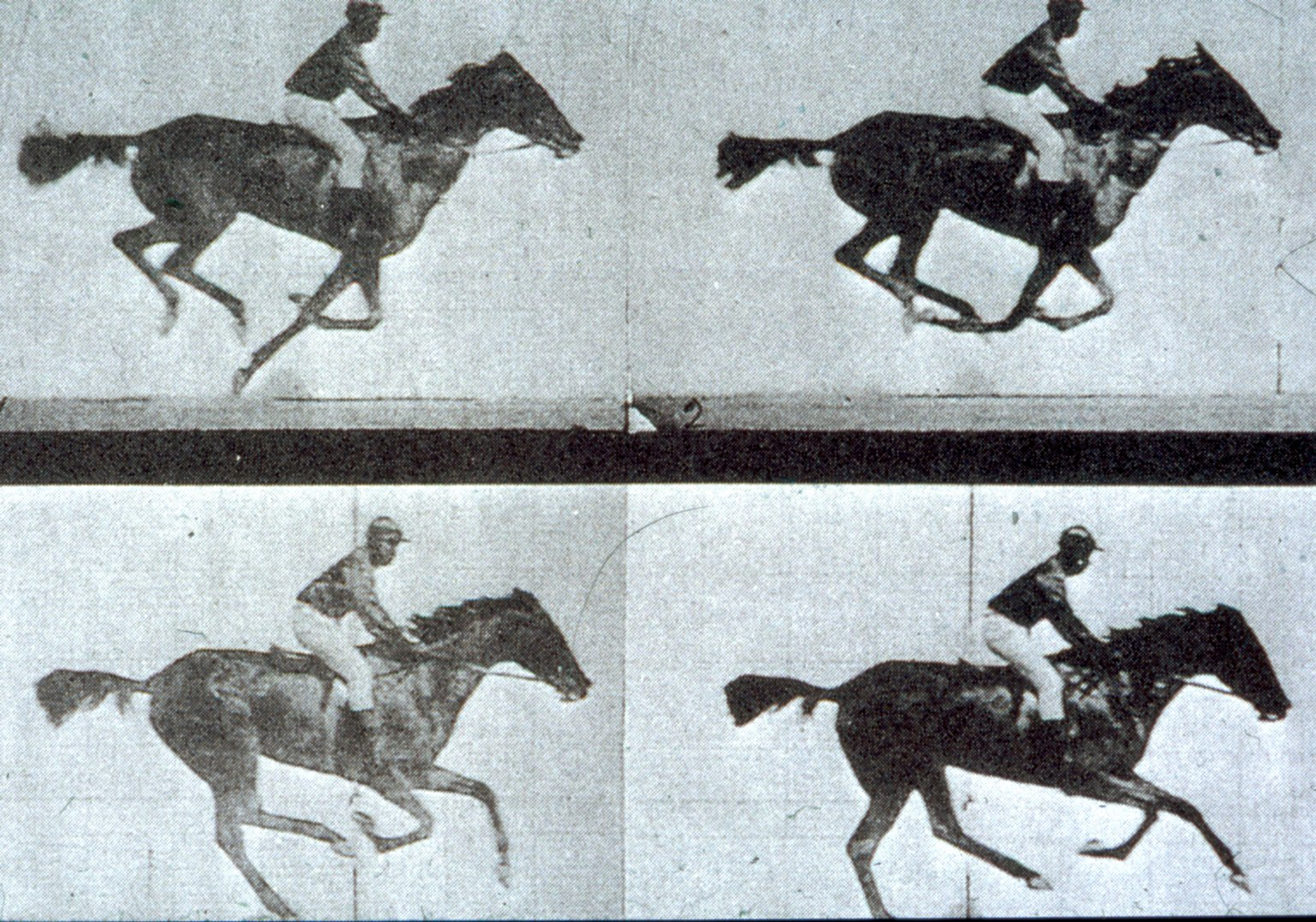
Provide photographer, title, year
Eadward Muybridge, Stop motion sequence, 1872
significance: Muybridge was a photographic surveyist in the West, and then he also pioneered stop motion through studies with the movement of horses. Their gait was never fully visible to the human eye before Muybridge.
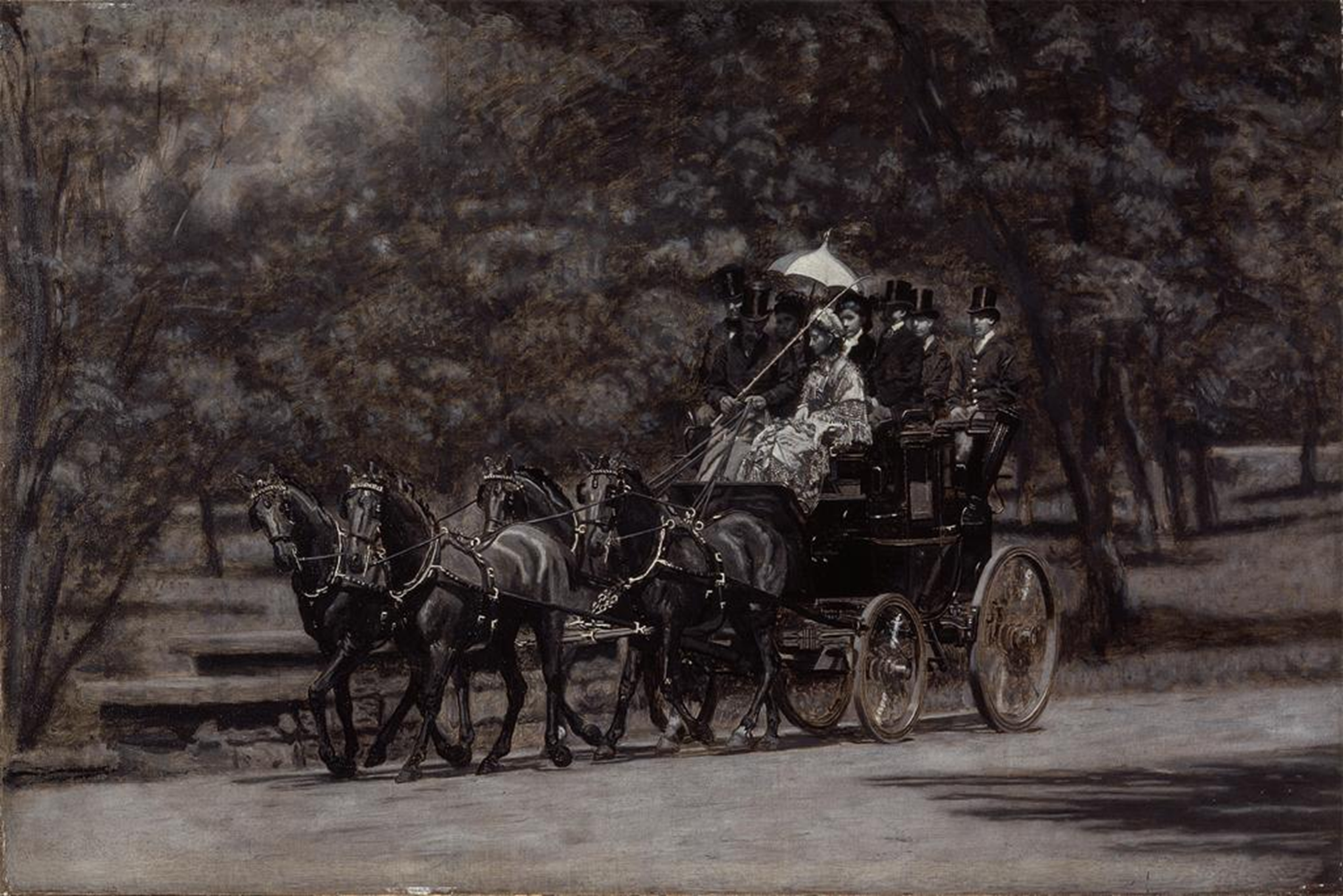
Provide photographer, title
Thomas Eakins, grisaille study for “Fairman Rogers’ Four-in-Hand”
significance: Eakins drew on stop motion photography studies like those of Muybridge to paint horses as accurately as possible, he is known for his meticulous detail
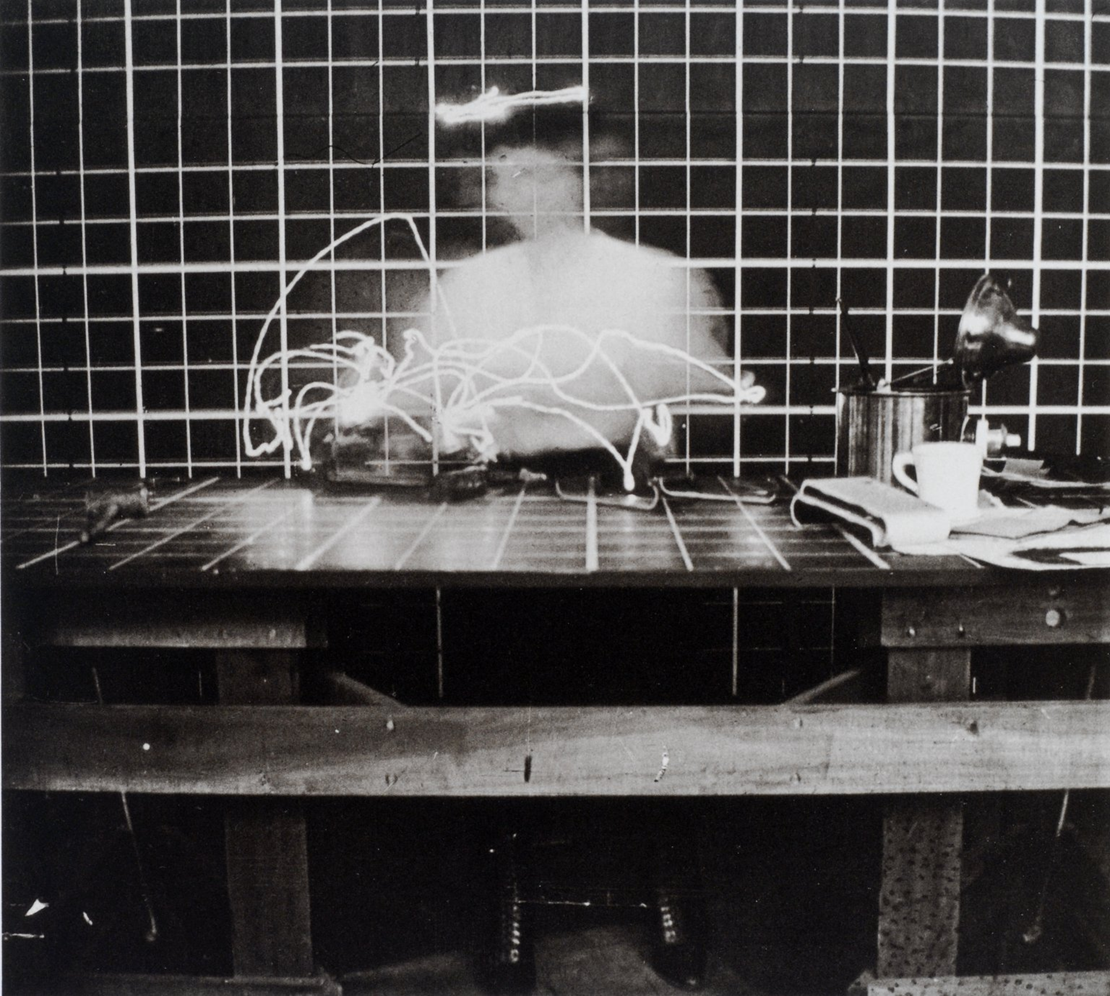
Provide photographers, title, and year
Frank and Lilian Gilbreth, “Time-Motion Efficiency Study” (1910-1924)
significance: the concept that time is money and motivation by time-motion studies is conveyed in the above photo, with the blurriness emphasizing the relationship between time and motion and movement and what we previously could not see with the human eye alone
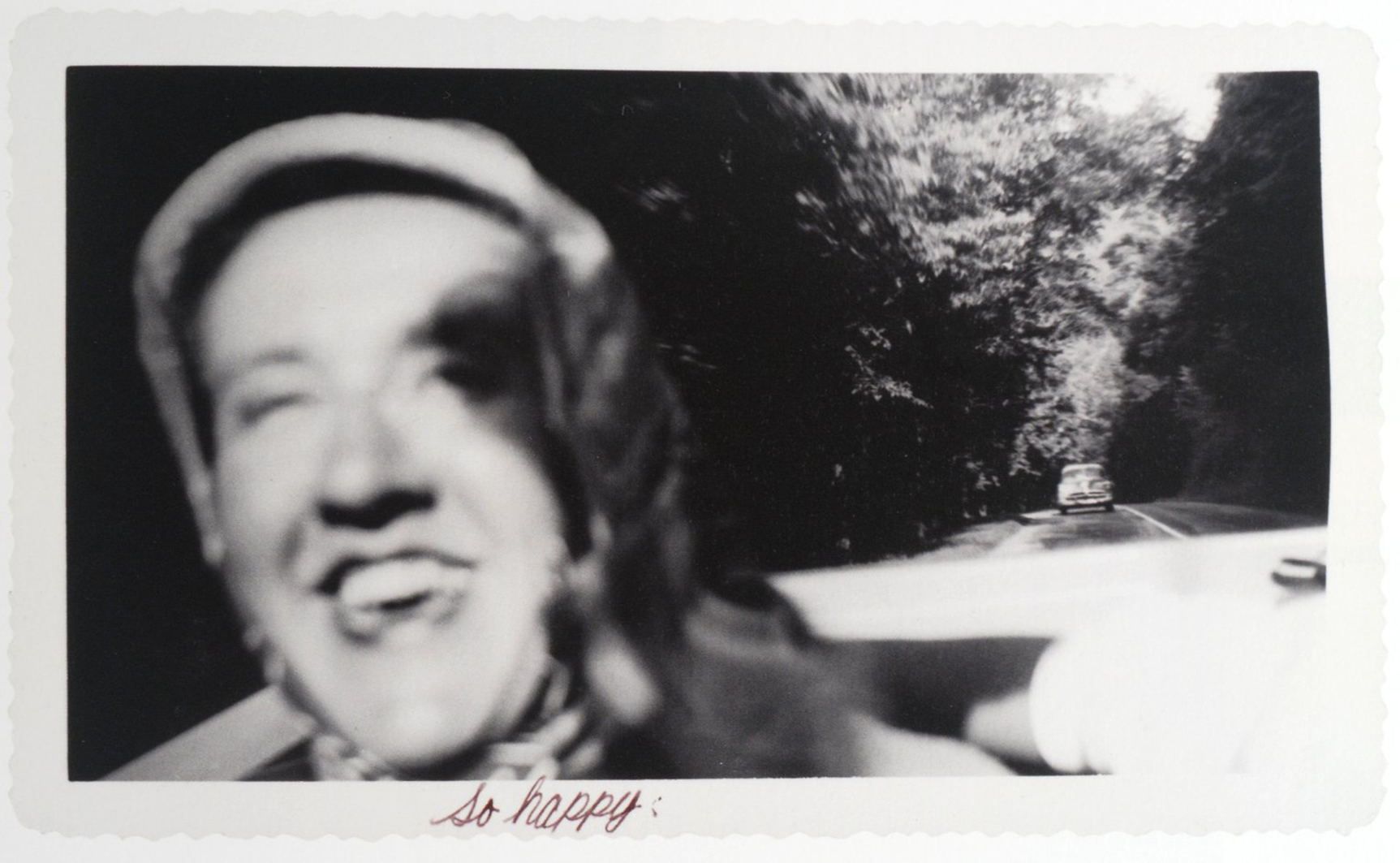
Provide context
Anonymous and undated photo, used as an introduction to our discussion on snapshot photography and shutterbugs (aka photography enthusiasts, more often than not amateurs)
significance: we are unable to truly decipher what the intended subject was. Was the focus on the up-close person yet that is slightly blurry, or the road and scenery trailing the car? One aspect of amateur photography is that it is much more open to interpretation than professional (the focus and meaning of the photo isn’t typically taken into account for the public view interpreting this at the time the snapshot photographer took this)
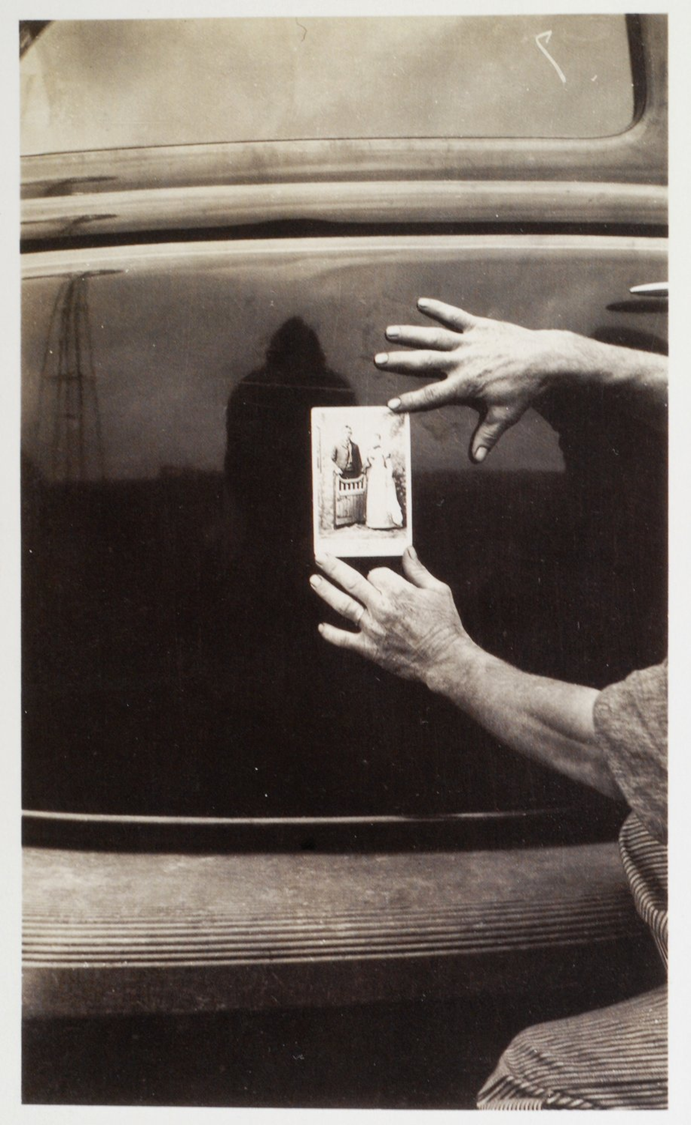
Provide photographer, title, and date
Anonymous, “Rosa”, 1930
significance: we discussed in class the broader context and meaning of this photo. Someone, who’s hands are the only aspect you can see of their person, is photographing an older family photo using the car window as the background. The reflection in the car window, including the photo taker’s body, an electrical tower and the flat landscape in the background are likely unintentionally captured, yet add additional meaning to the very moment in time that this photo was taken —> these unintentional, or unthought out aspects of the photo are likely that of amateur photography
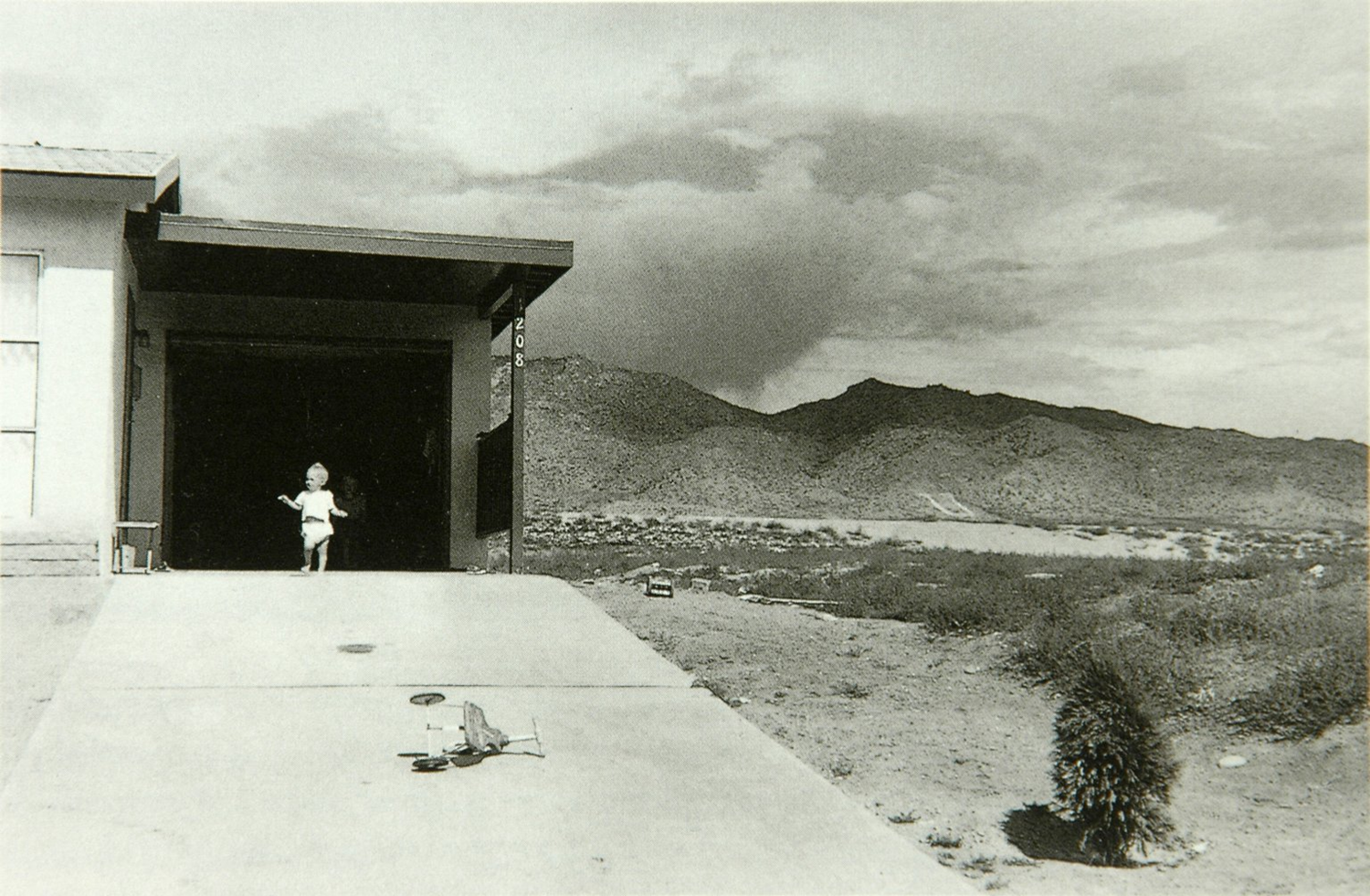
Provide the photographer, title, and date
Gary Winogrand, “Albuquerque, New Mexico” (1957)
significance:
draws on the snapshot aesthetic; part of the snapshot photography lecture
a snapshot might just focus on the child and bicycle, but Winogrand deliberately chooses to include the landscape, signs of intention that adds detail and meaning to the image
this is art photography and less so amateur shutterbug work
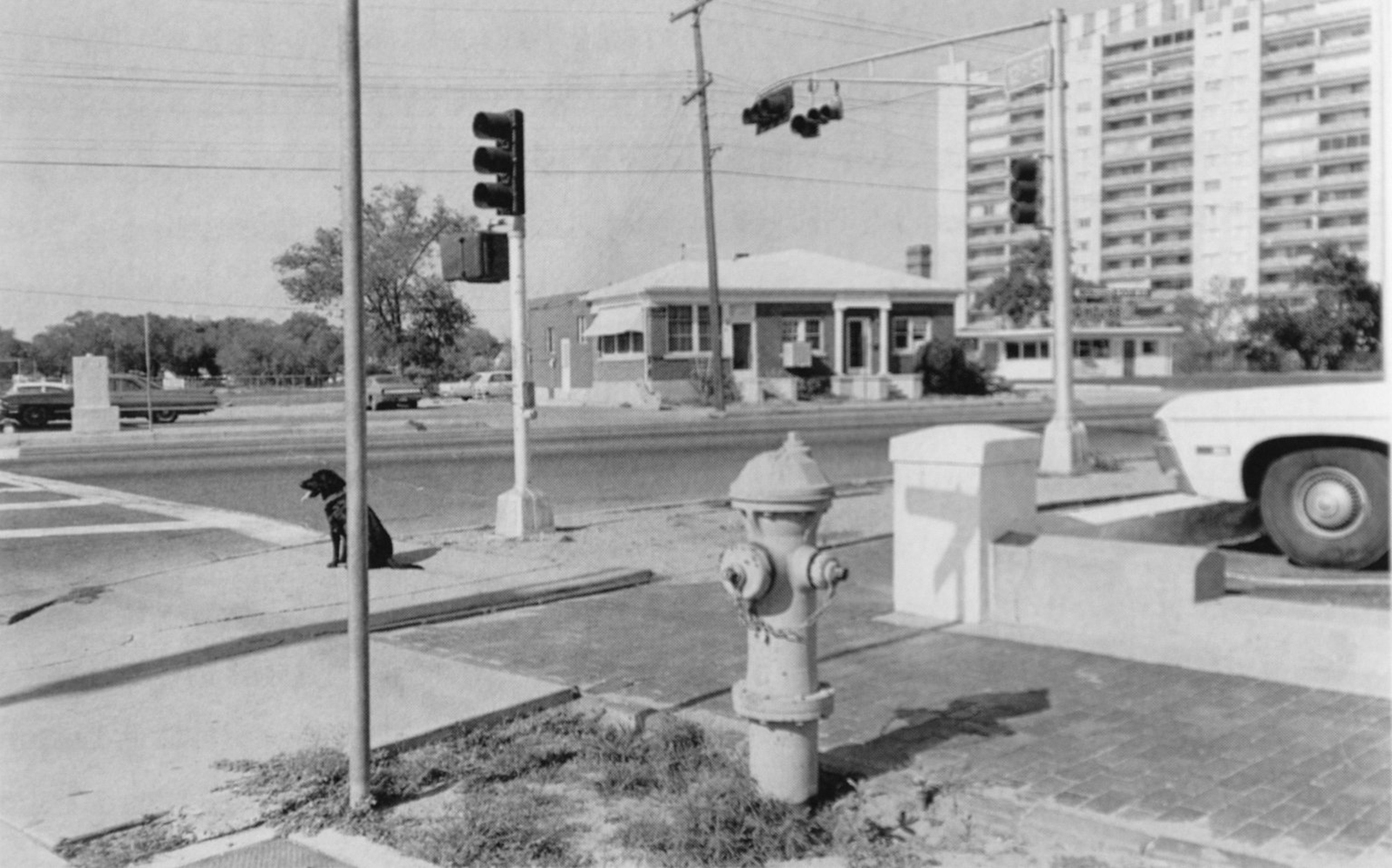
Provide photographer, title, and date (NOT COVERED IN CLASS)
Lee Friedlander, “Albuquerque, New Mexico”, 1972
significance: part of the snapshot photography lecture. Looks like amateur photography at first b/c of the lack of true focus on any one subject/object without interference from another object (but this is intentional, and carefully angled as such, something that can only be done by a professional aka Lee Friedlander)
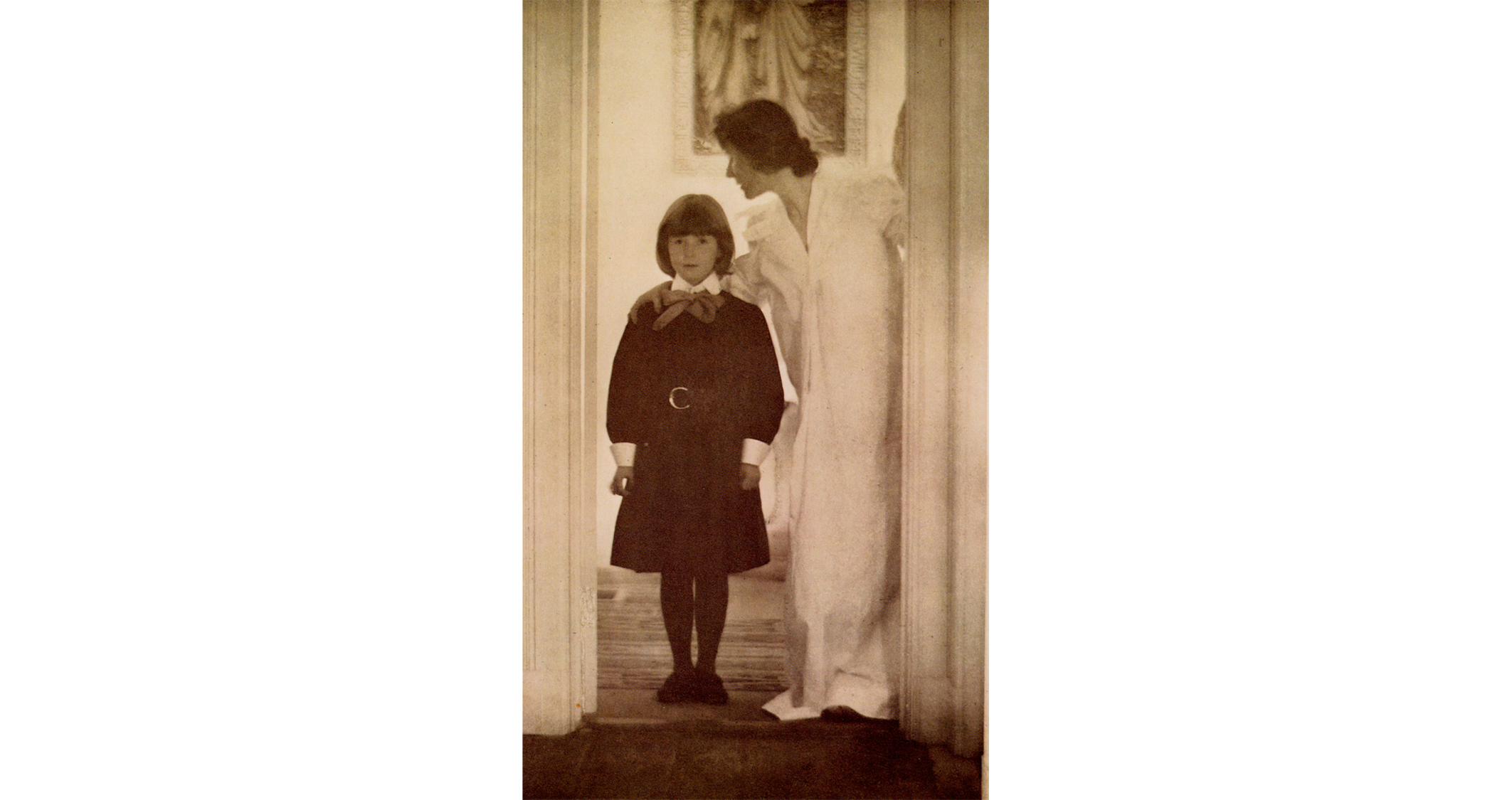
Provide photographer, title/subject, type and year
Gertrude Kasebier, “Blessed Art Thou Among Women”, platinum print, 1899
significance: part of the Pictorialist (photography as a fine art) to Straight Photography (not trying to make photos look like paintings and drawings) lecture
woman on right represents a woman’s values more than a woman in that time period
main subject is the little boy - dark clothing pops out in contrast to whites around him
very stagged (Steiglitz may not like this and say it is “mechanical”)
all about the woman in the household and supporting a child into society, links to protestant values/symbols with mother Mary in photo in back
using STRAIGHT PHOTOGRAPHY to explore the world and societal values (Paul Strand and Alfred Stieglitz both played important roles in breaking from the photo secession movement and the emergence of straight photography.)
straight photography was characterized by no brush work, depicting clear detail
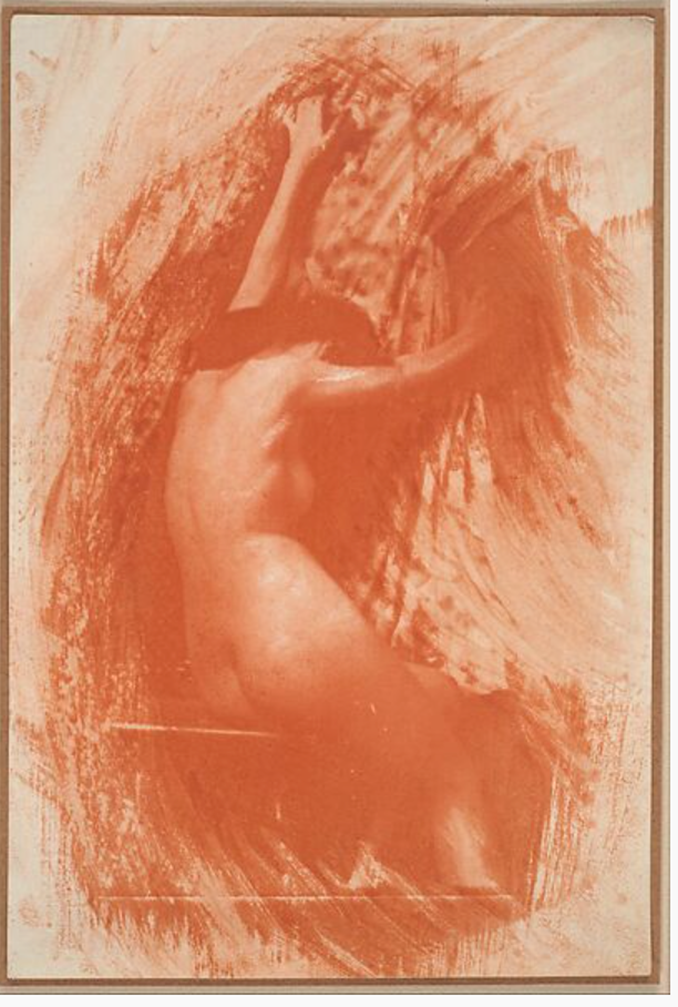
Provide the photographer, title, date
Robert Demachy (French), “Struggle”, 1903 or later
significance:
Sienna colored crayon—> evoking a tradition of fine art drawing
used the process of gum bichromate, which is an emulsion that can be manipulated after the photo is printed
using a thumb or brush to get the effects —> placing his physical touch
may not have been shocking as a nude to the public bc it looks more like a painting/drawing than as real as a photo
very characteristic of NOT STRAIGHT PHOTOGRAPHY (more photo secessionist and PICTORIALIST)
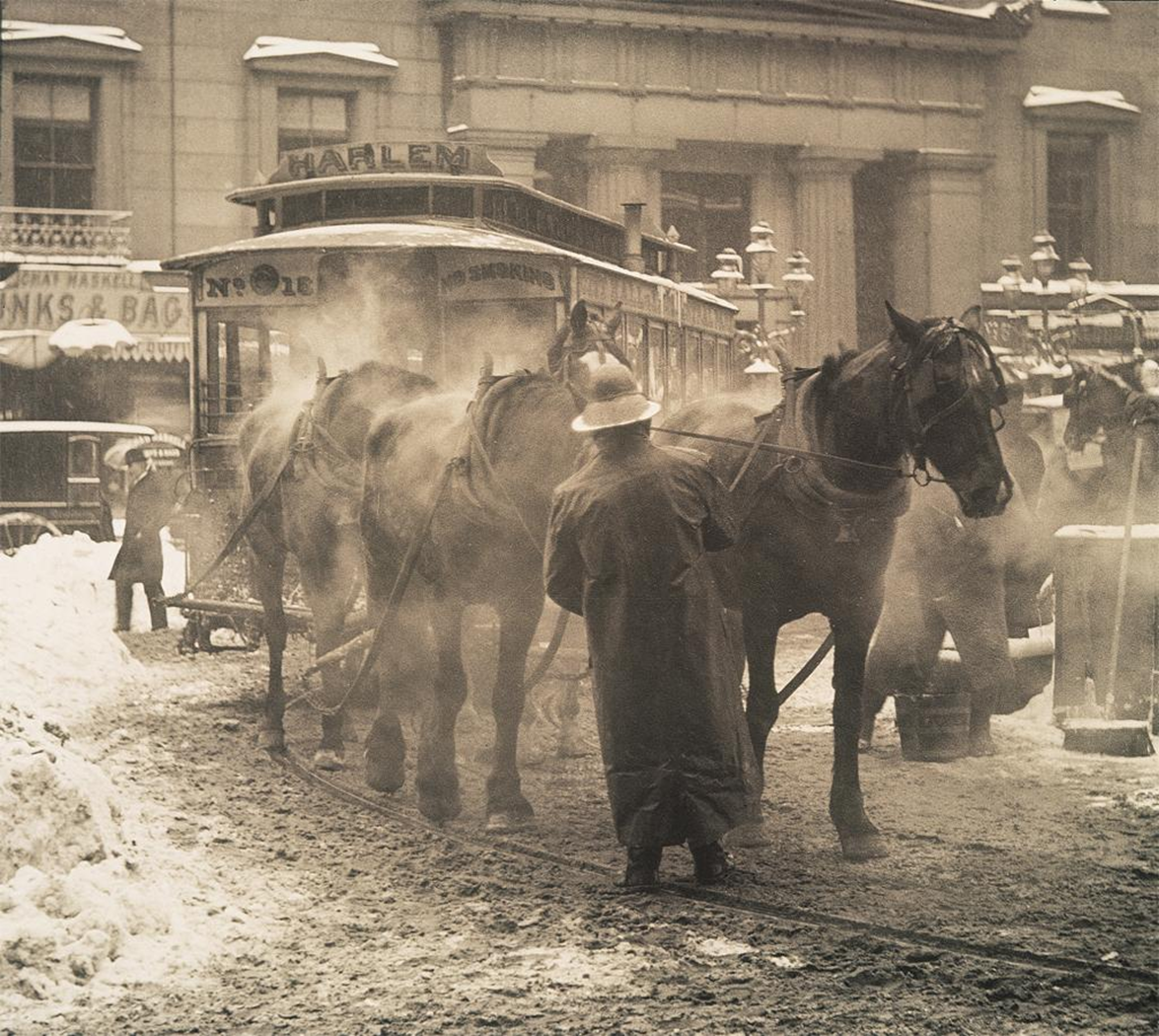
Provide photographer, title, date
Alfred Stieglitz, “The Terminal”, 1893
significance:
Stieglitz moved away from the photo secessionist movement and to straight photography around this time
less painting-like details
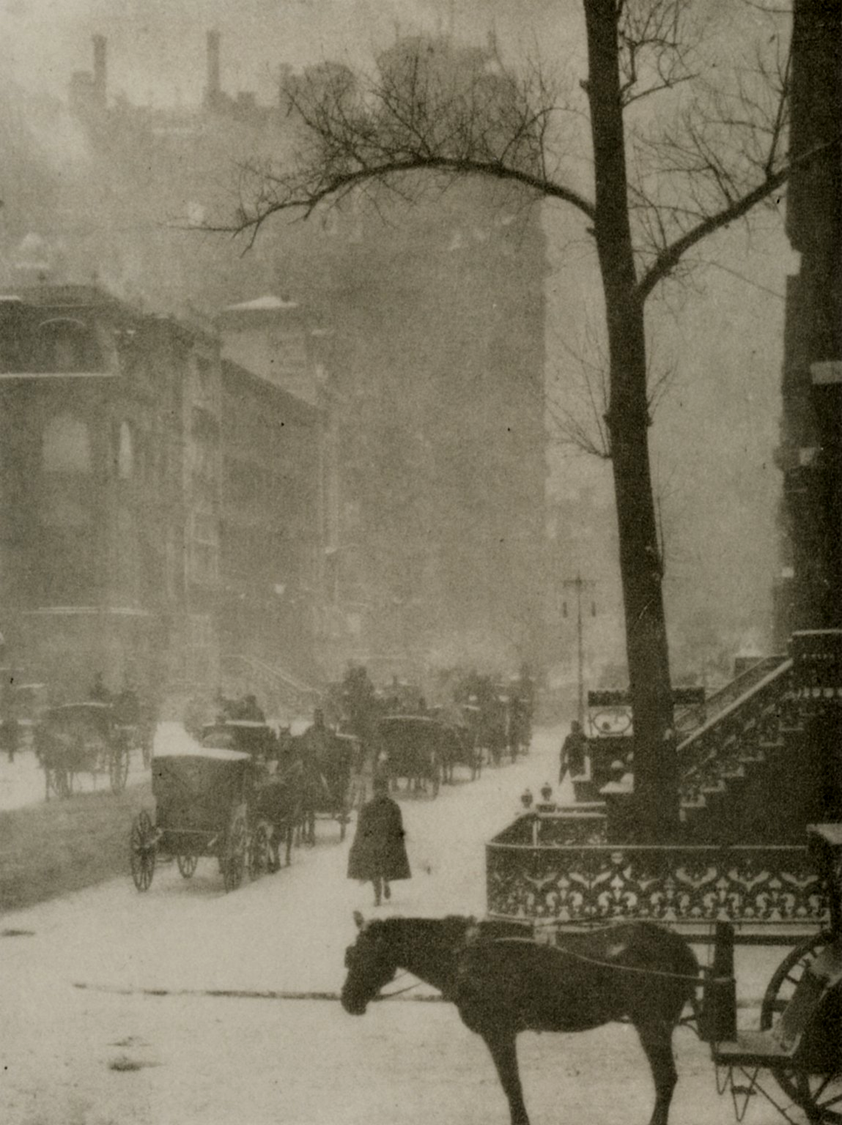
Provide photographer, title, year
Alfred Stieglitz, “The Street—Design for a Poster”, 1901
significance:
continuation of Stieglitz’s move away toward straight photography
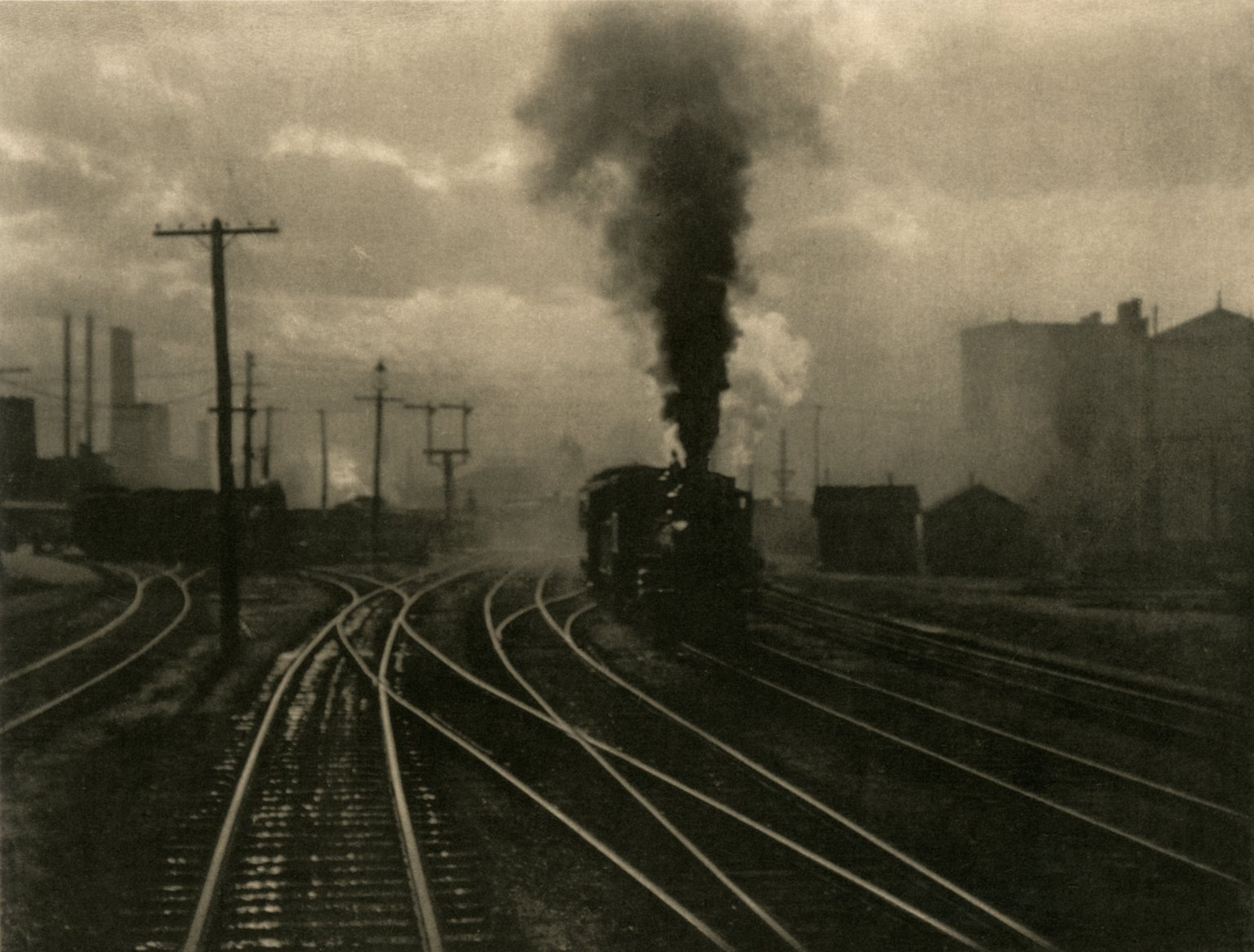
Provide photographer, title, and date
Alfred Stieglitz, “The Hand of Man”, 1902
significance:
again, we see that Stieglitz has moved toward straight photography
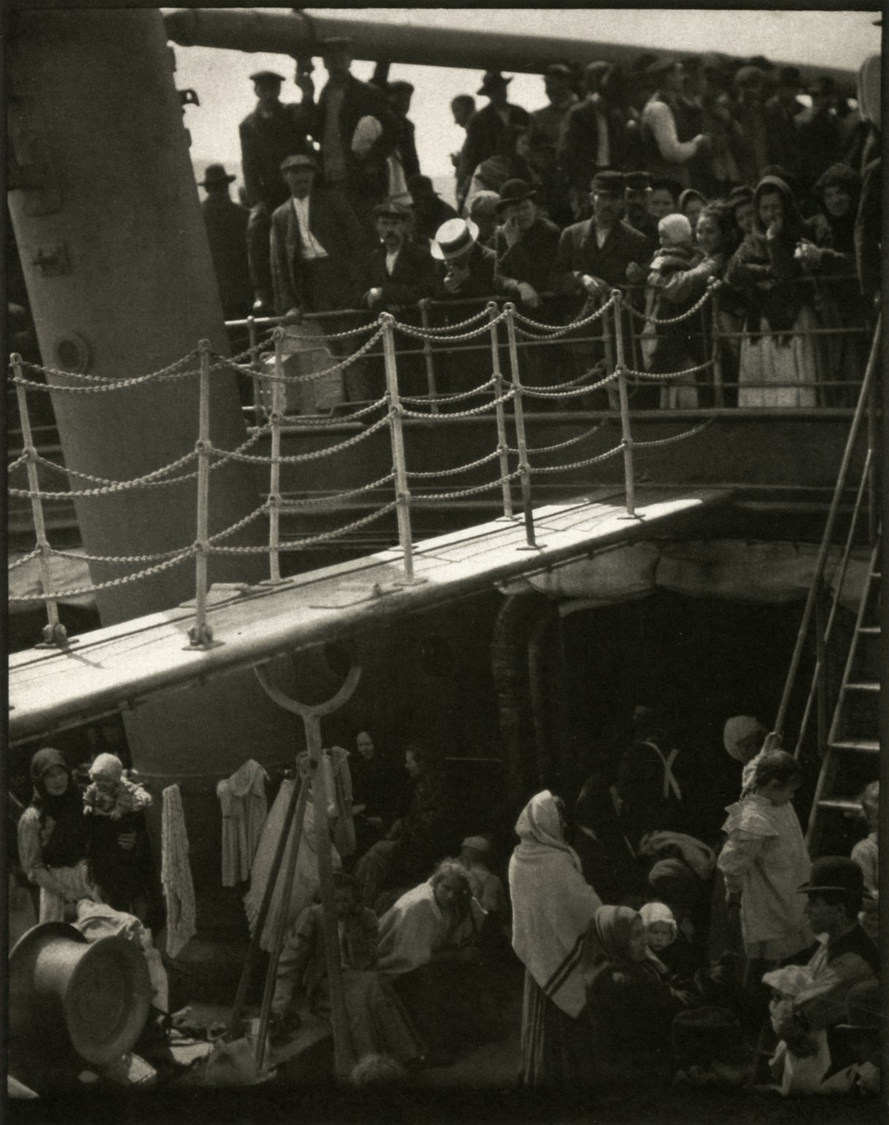
Provide photographer, title, year
Alfred Stieglitz, “The Steerage”, 1907
significance and context:
Stieglitz was on a trip sailing to Europe with his family. He hated the atmosphere of the first class. When he couldn’t stand it anymore, he went as far forward on the deck as he could and looked down at the lower level with the lower class. This fascinated him, the whole scene, the people and structures of the ship together
he aimed to photograph not only the objects in front of him, but TO CAPTURE WHAT HE FELT and the vision that held him - the common people, the feeling of ship and ocean and sky and the feeling of relief that he was away from the mob called the rich
he uses photography to devolve back to himself, his interests, to depict how he feels about the photograph more than its actual contents and the social (economic status) content
people he fixated on in his fascination with this scene were the lady holding the young child on the upper deck, the man with the sombrero to her left on the upper, a man and woman talking on the lower, the white draw-bridge with its railings make of circular chains, truly focused on the small details
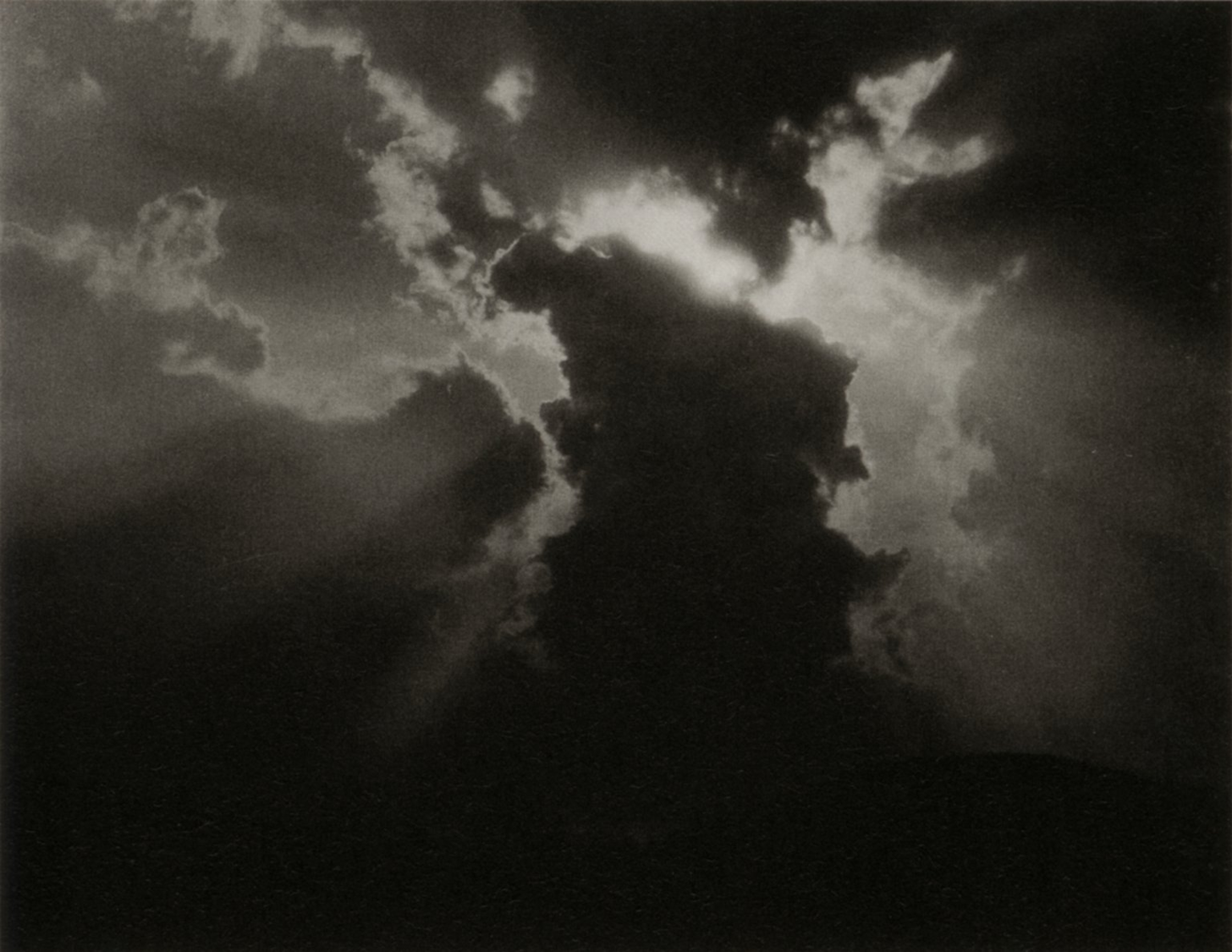
Provide photographer, photo series title, and date range
Stieglitz, “Equivalents” series, 1925-1934
significance:
part of Stieglitz and Strand: Two kinds of “straight” photography lecture
Stieglitz switches his focus to clouds, really showing an EXPRESSION OF THE FEELING he had at the moment that he wanted to replicate
“when the photographer shows us what he considers to be an Equivalent, he is showing us an expression of a feeling, but this feeling is not the feeling he had for the object that he photographed. What really happened is that he recognized an object or series of forms that, when photographed, would yield an image with specific suggestive powers that can direct the viewer into a specific and known feeling, state or place within himself” - Minor White, “Equivalence: The Perennial Term” (1963)
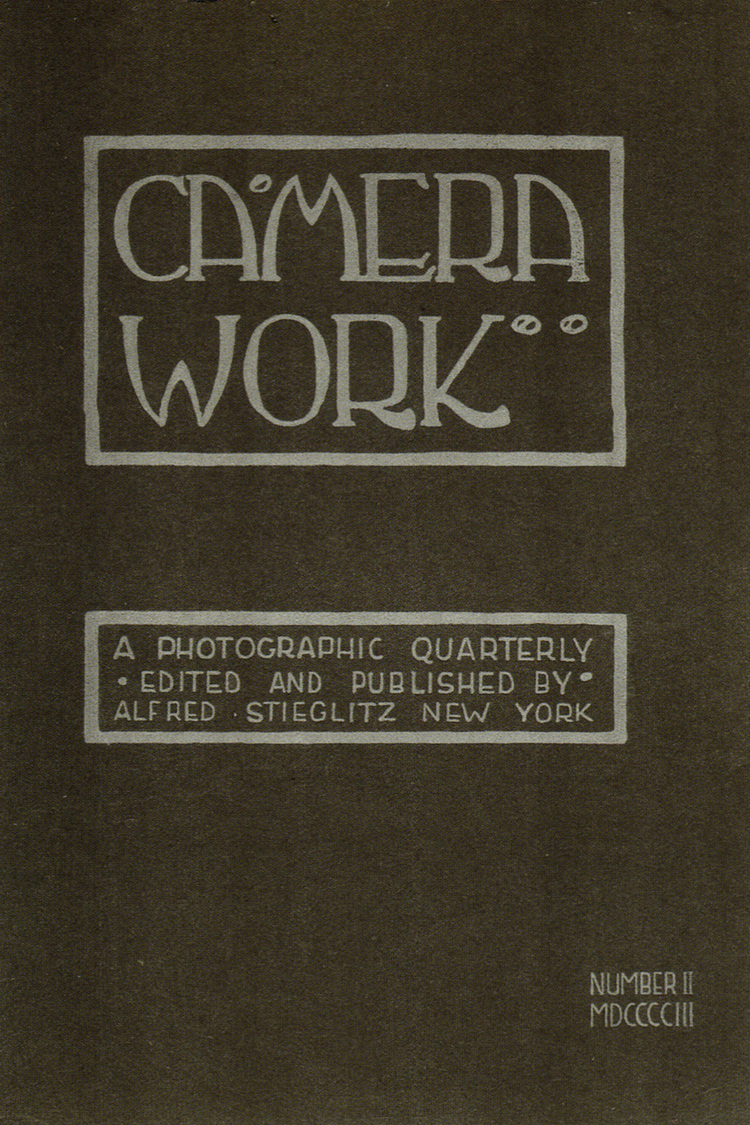
Provide context and significance
The front cover of Camera Work, a photographic quarterly edited and published by Stieglitz from 1903-1917
used this publication to promote photography as a fine art (part of pictorialism)
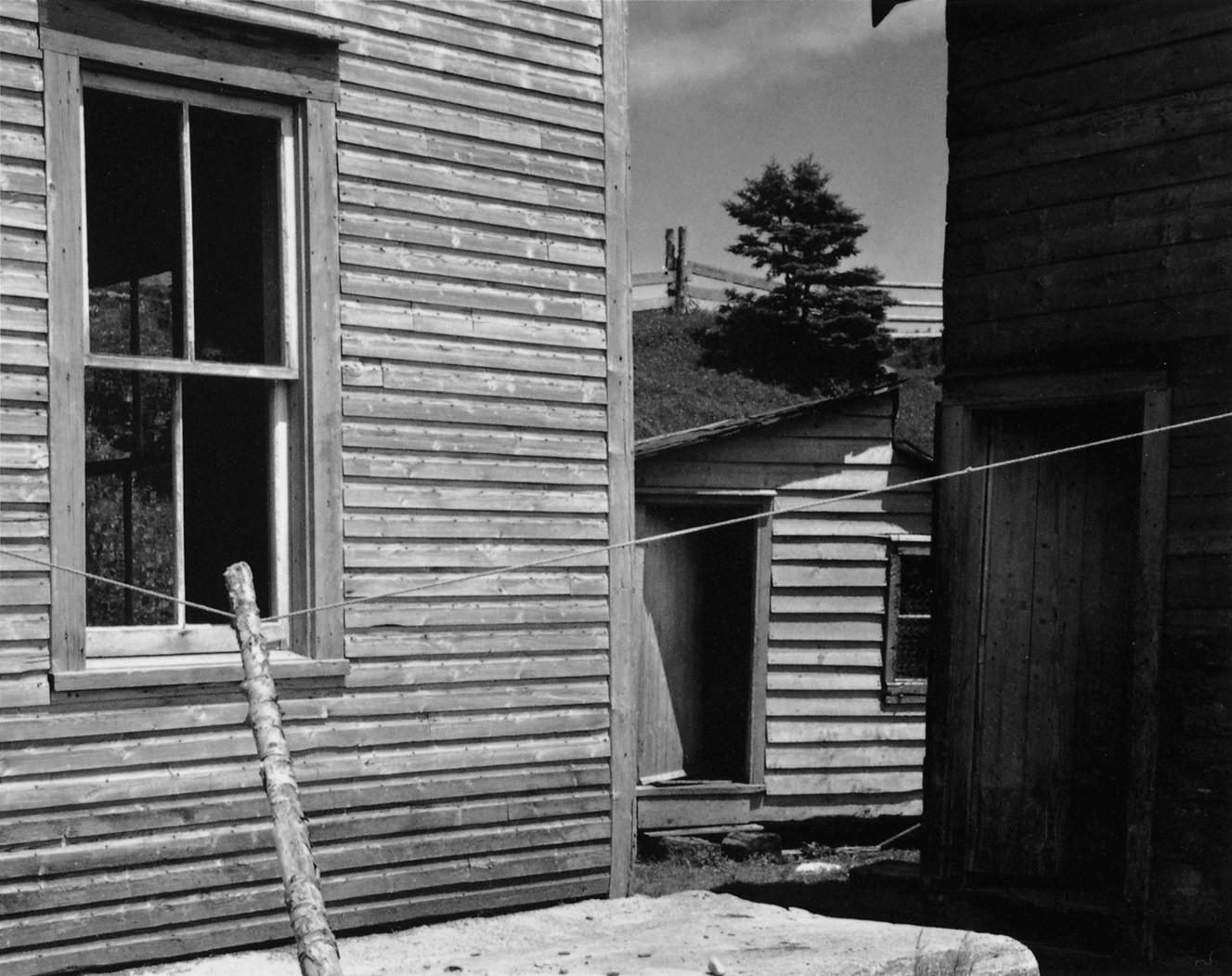
Provide photographer, title, year
Paul Strand, “House, Gaspe Peninsula, Canada”, 1929
significance:
Strand started as a Photo Secessionist, and shifted to straight photography from 1911-1915
straight photography showed in his work with honesty, intention, and objectivity
he also used straight photography to express a social vision and life just how it is captured - he stays long enough in places to understand and capture the sociological interest and tonal features
focused on tactility (Taos, NM)
abstract features yet a realism of social values
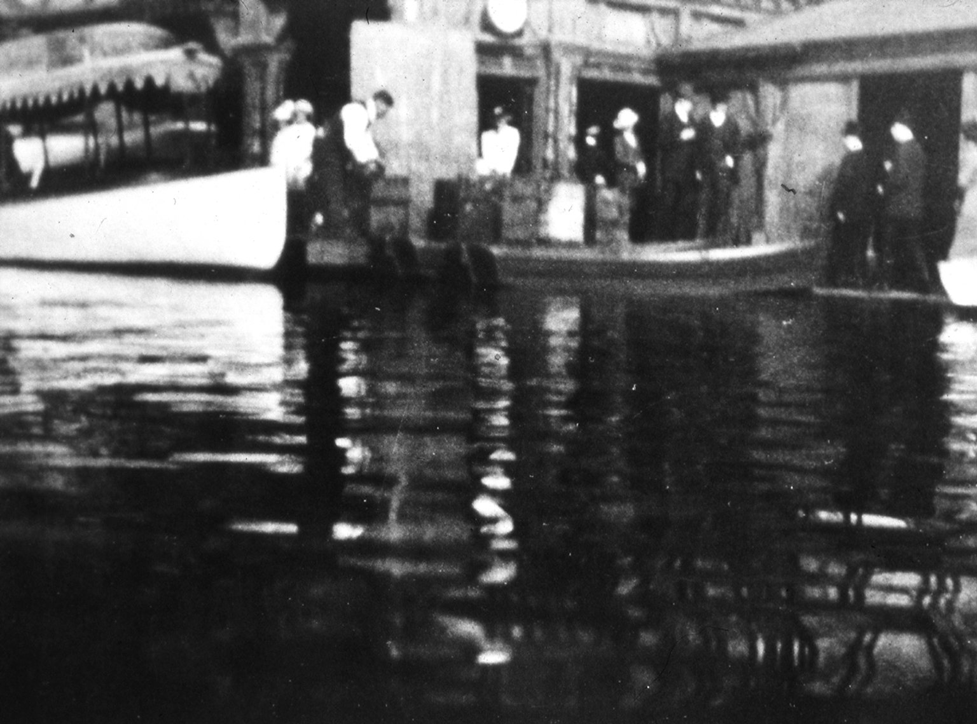
Provide photographer, title, date
Paul Strand, “Venice”, 1911
significance:
the beginning of his type of straight photography
uses abstract features yet a realism to depict social patterns and values
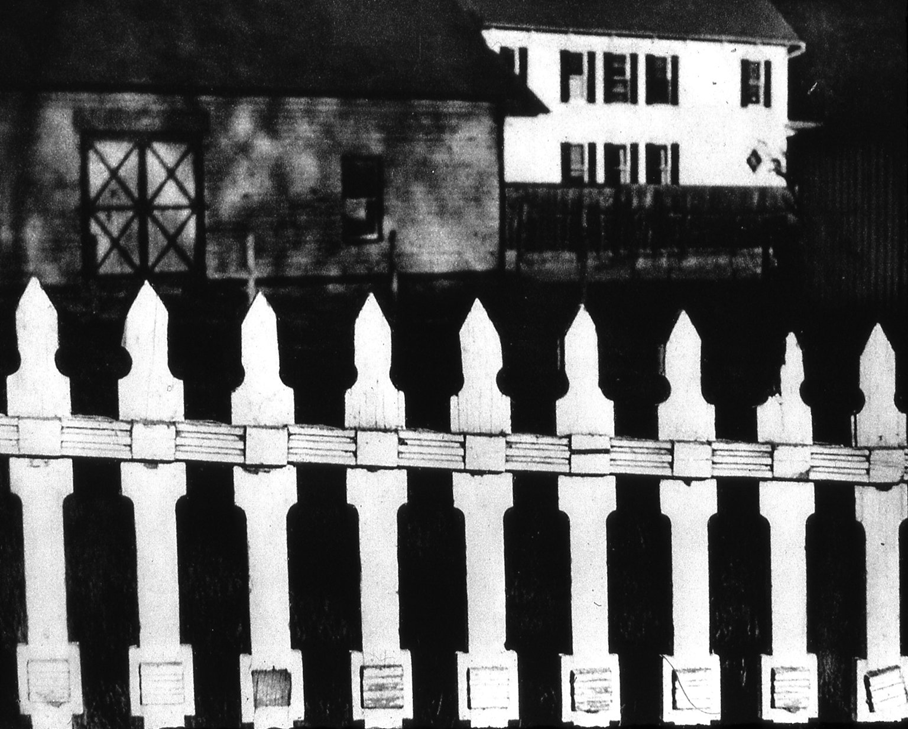
Provide photographer, title, date
Paul Strand, “The White Fence”, 1915
significance:
his type of straight photography
uses abstract features yet a realism to depict social patterns and values
showing everyday life and objects (i.e. a fence and houses) with an abstract realism
such a stark white fence jumping out at you in contrast with the dark background that it looks almost 2D and not completely real
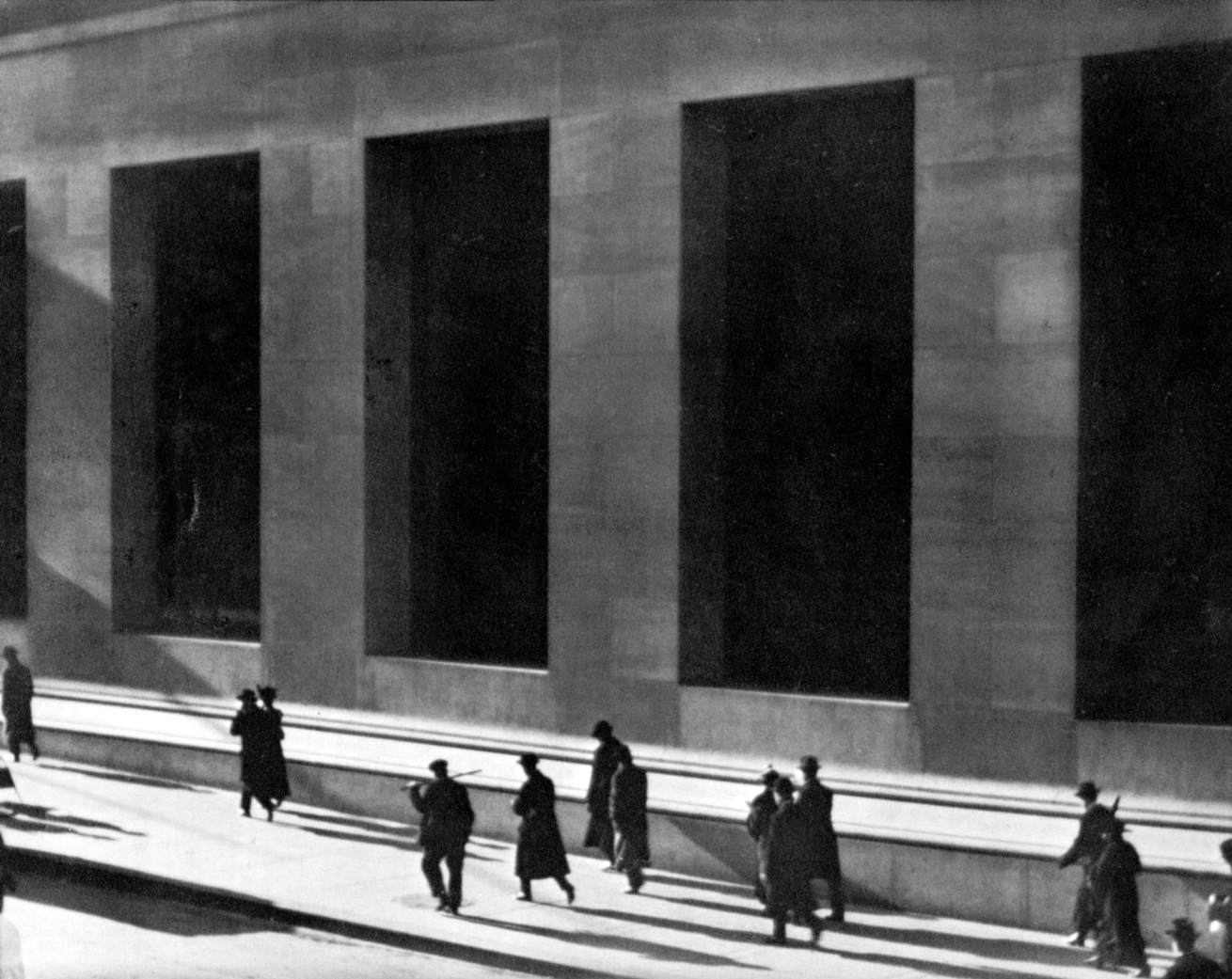
Provide photographer, title, year
Strand, “Wall Street”, 1915
significance:
shows realism and stark contrast between light and dark to depict clear detail and objectivity and everyday people patterns walking down Wall Street of straight photography
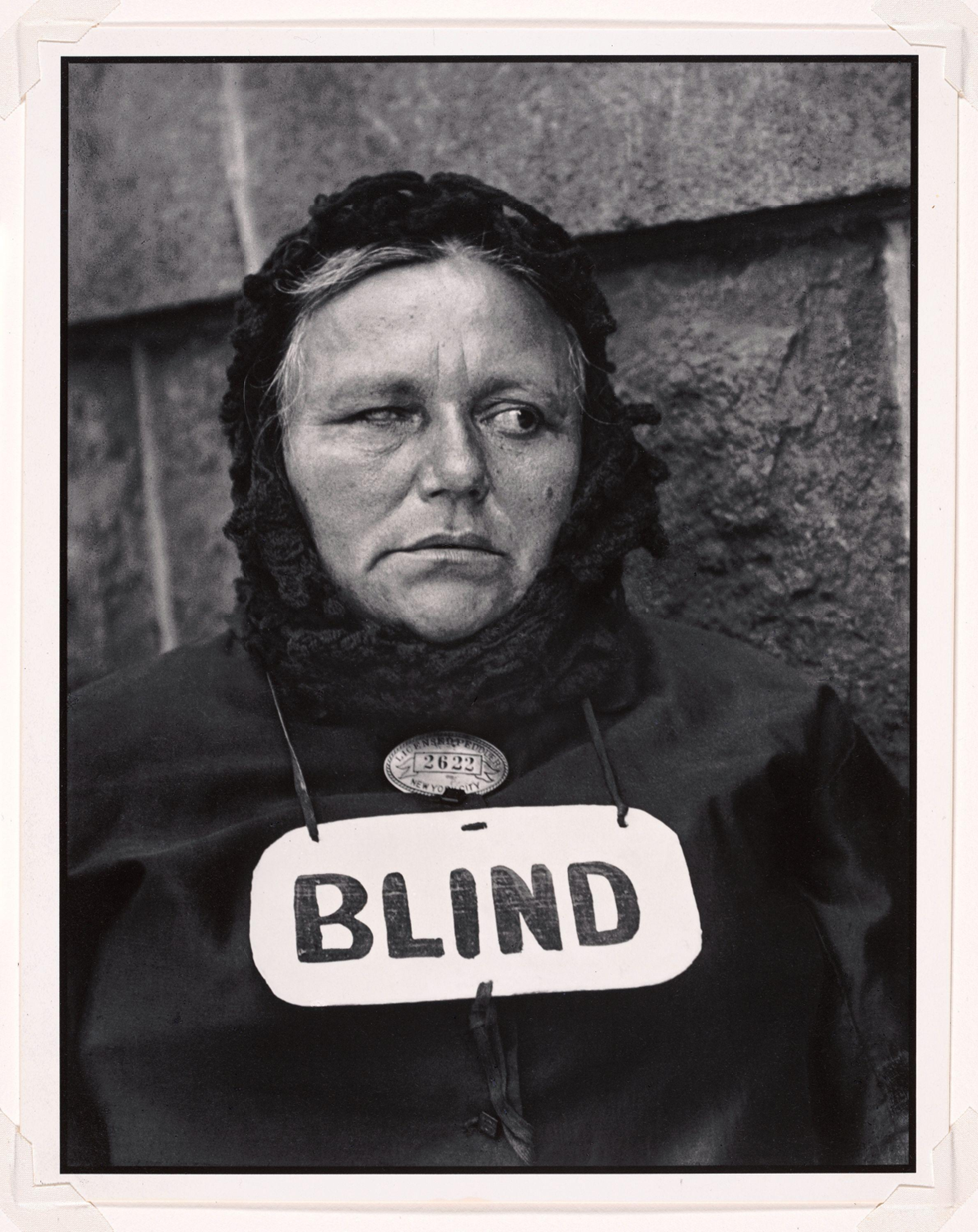
Provide photographer, title, year
Strand, “Blind Woman”, 1916
significance:
Strand’s style of straight photography
contrast between light and dark
shows realism and raw society with this up close and personal portrait of a blind woman
shows her objectivity with focus on the “blind” sign
social exchange and a moment of opening up one’s privacy
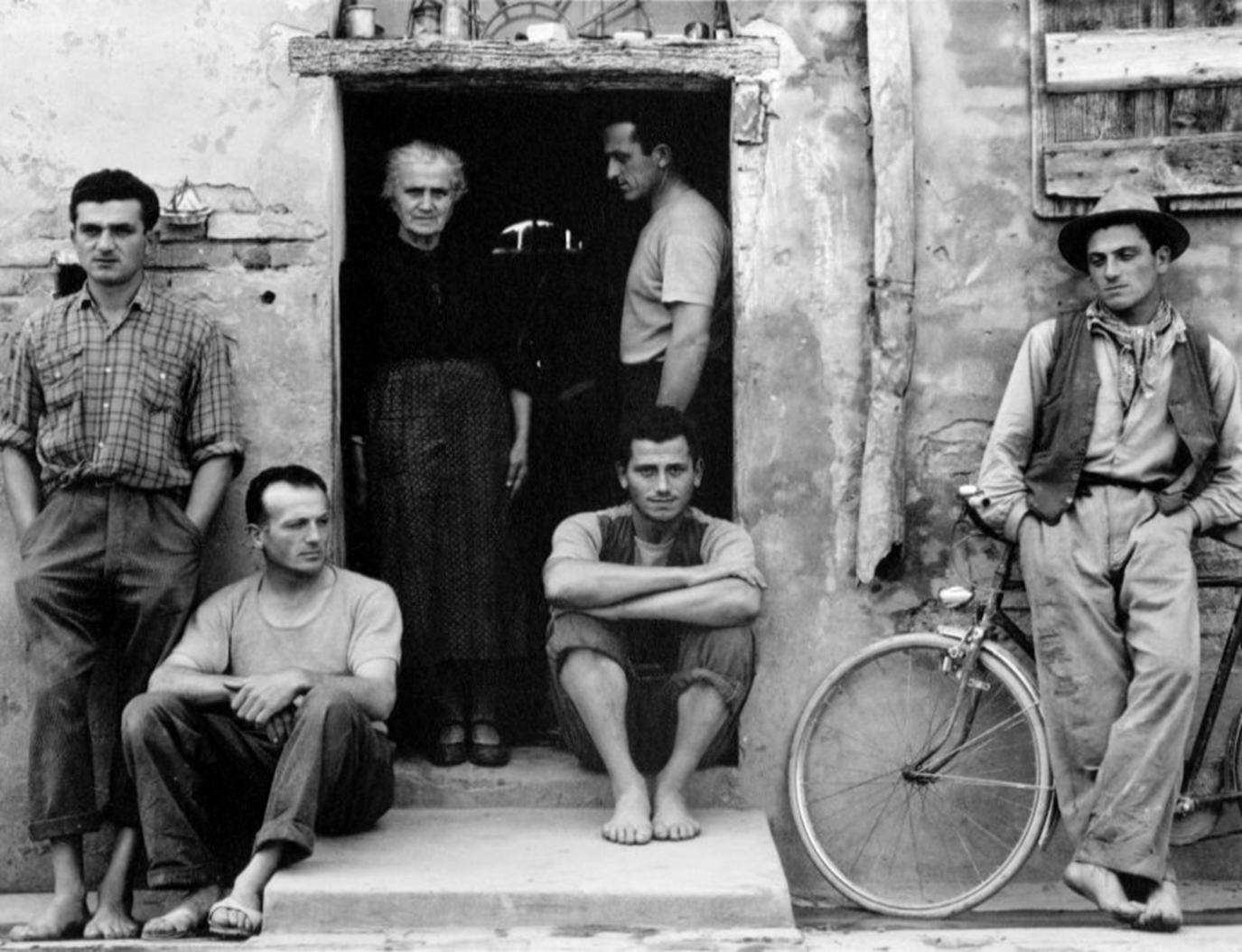
Provide photographer, title, date
Strand, “The Family, Luzzara (Po Valley), Italy”, 1953
significance:
directness and honest and getting up close and personal with the normalness of life with these subjects (members of an Italian family casually presenting themselves)
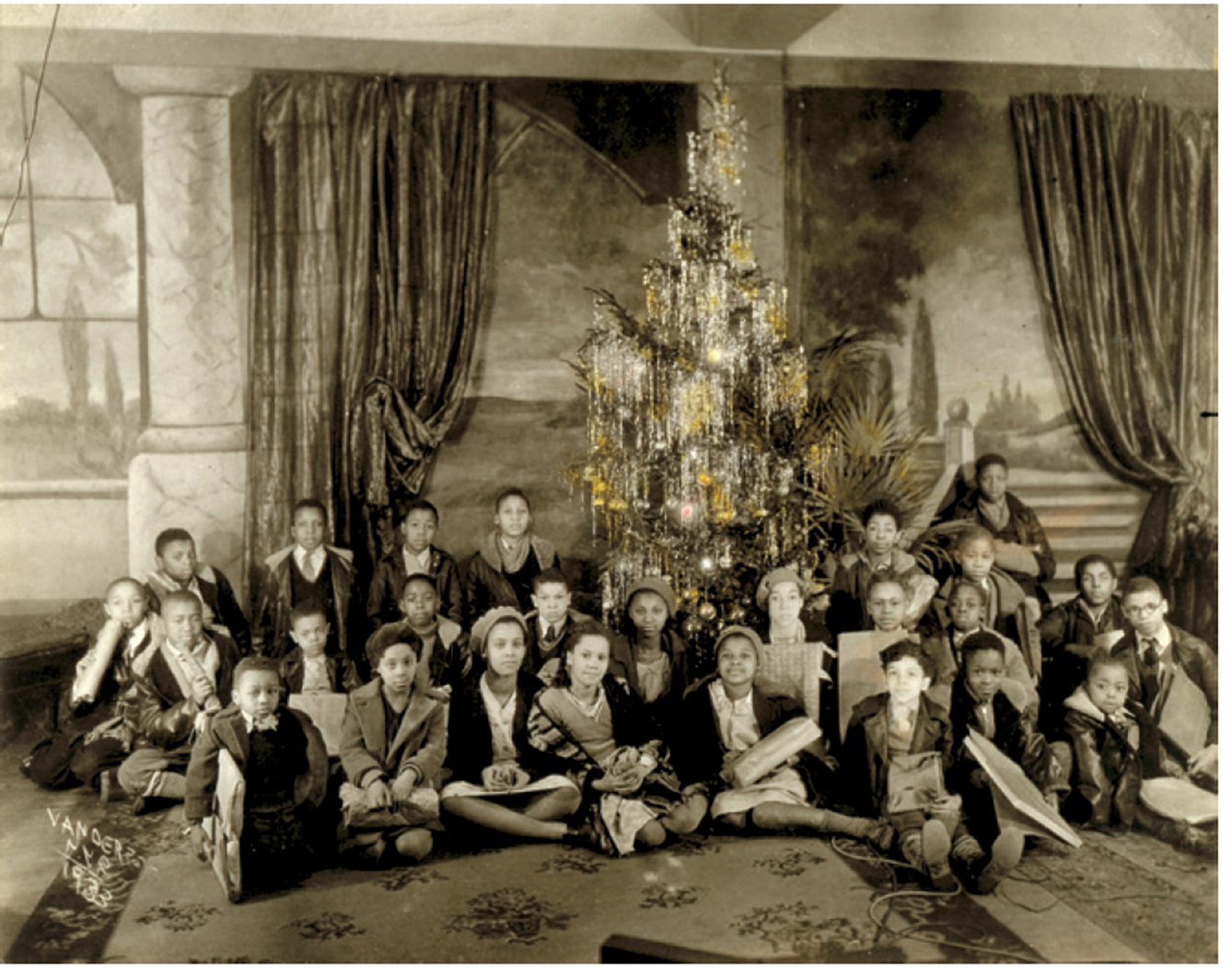
Provide photographer, title, year
James Van Der Zee, “Children in Front of a Christmas Tree at G.G.G. Photo Studio”, 1933
significance:
Van Der Zee was an black Renaissance photographer from Harlem in the 1920s and 1930s
captured intimate family portait that he made public and recognized as art and telling an interpreted story of him family
sometimes intentional stagging, sometimes not portraits
Van der Zee was multifaceted in his uses and registers of photography, revealing the QUOTIDIAN as a central idiom of African diasporic photographic practice (Emillie Boone)
quotidian, nimbleness in his photography and quick adaptation to his clients’ wants (Emillie Boone)
elements of both fine photography and vernacular photography pictures (Emillie Boone)
quotidian/vernacular photography —> depicts ordinary and everyday, often informal photographs taken by usually non-professional photographers. Typically capture candid moments of family life, social events, cultural practices, etc.
this “Children in Front of a Christmas Tree at G.G.G. Photo Studio” is both staged and intimate
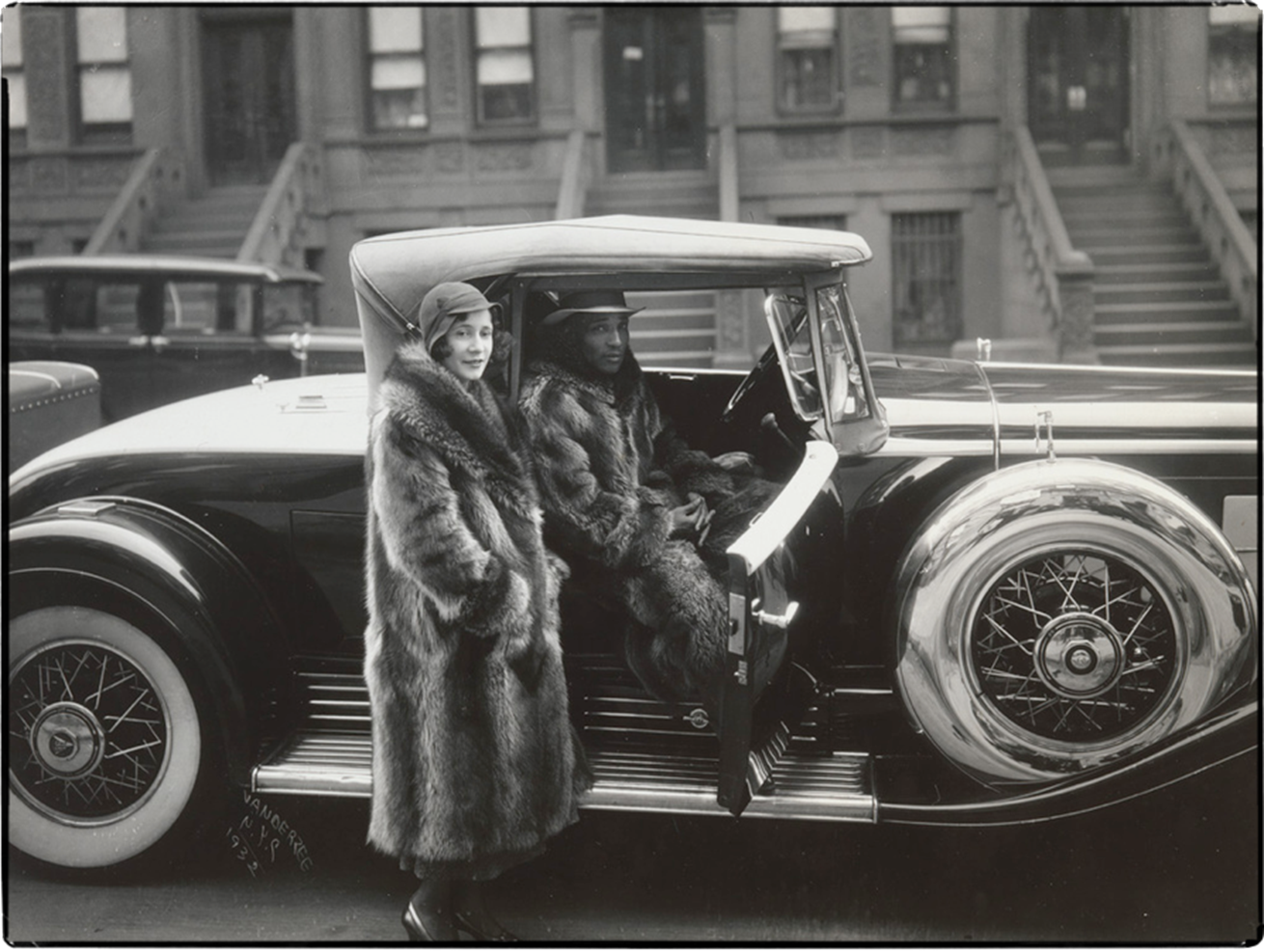
Provide photographer, title, year
James Van Der Zee, “Harlem Couple”, 1932
significance:
a well known work of Van Der Zee
often interpreted for its context within the Harlem Renaissance movement and art history of photography, rather than taking a vernacular lens that was probably more true (“His photographs are regularly discussed in art history classrooms and frequently appear within academic publica tions as representative of the Harlem Renaissance era’s New Negro sub ject, even though, remarkably, Van Der Zee had no direct contact with 3 to PIvot lIghtly any of the artistic movements of Harlem during his more than fifty years of operating a studio” - Emillie Boone)
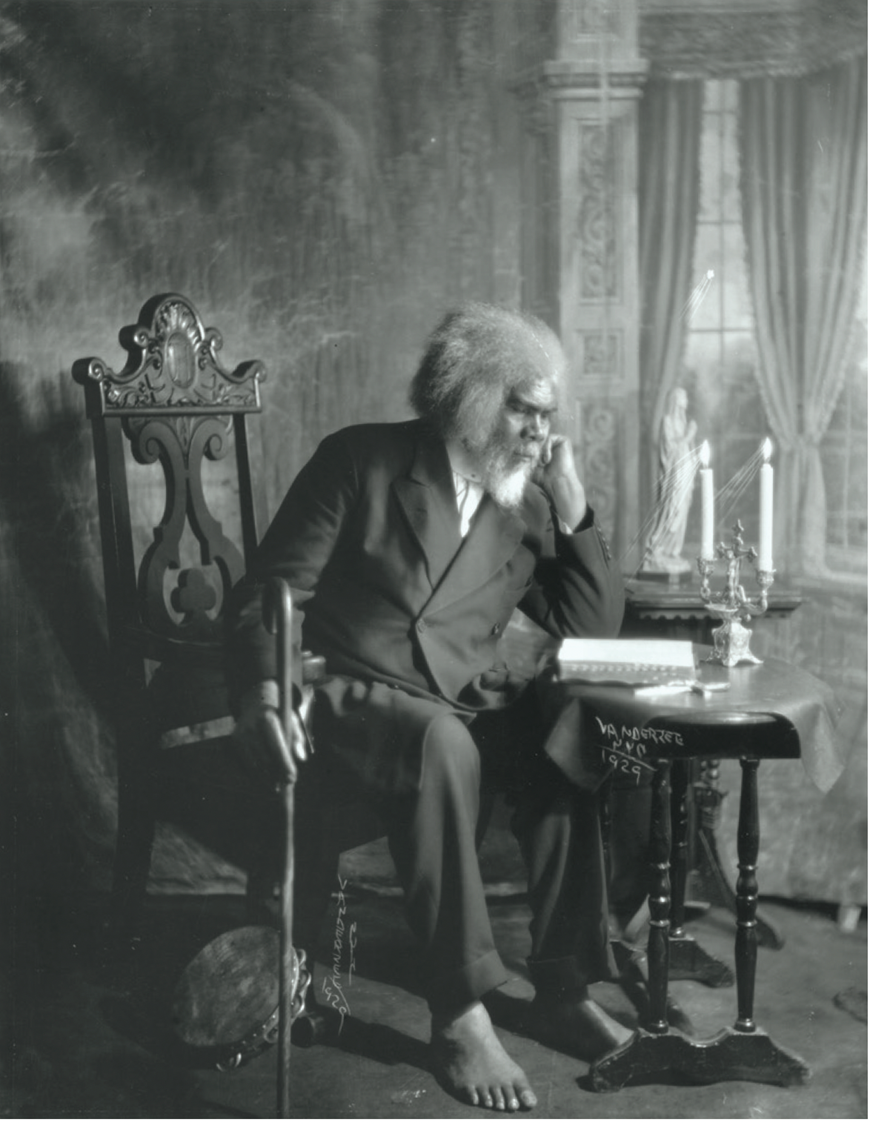
Provide photographer, title, year
James Van Der Zee, “Barefoot Prophet”, 1929
significance:
subject is the nearly 7-foot tall Elder Clayhorn Martin seated and dressed in a dark suit while barefoot, his usual appearance when preaching
a posed subject with carefully selected props
an elegant aesthetic quality, incorporating a carefully arranged setting evocative of Victorian mores —> conveys the utmost sense of respectable style and sensibility
carefully posed and situated within the space, along with the natural and compelling countenance of the sitter
this careful posing and selected props is characteristic of Van Der Zee’s portraits
“Held toward the light, all substance seems to vanish form the picture: the highlights grow darker than the shadows … yet as soon as it is moved away from the light and contemplated form a certain angle, the image reappears, the mere shadow of a countenance comes to life again.” - ____
Sadakichi Hartman (early 20th century)
context:
talking about the viewing experience of the daguerreotype, having to view it form a very specific angle, which also gives it a personal and private element
“If we examine a work of ordinary art, by means of a powerful microscope, all traces of resemblance to nature will disappear—but the closest scrutiny of the photogenic drawing discloses only a more absolute truth, a more perfect identity of aspect with the thing represented. The variations of shade and the gradations of both linear and aerial perspective are those of truth itself in the supremeness of its perfection".” - ___
Edgar Allen Poe, “The Daguerreotype” —> describing the viewing experience that the daguerreotype helped form (closest scrutiny of the photo that reveals truth)
“There is distinct subjectivity — or, perhaps, lack thereof — that emerges from most old photographs. There is something in the eyes that suggests a way of being in the world that is foreign and impenetrable to us. The camera itself seems to be a double cause of this dissonance. First, the subjects seem unsure of how to position themselves before the camera; they are still unsettled, it seems, by the photographic technique. They also seem to be wrestling with the camera’s gaze. They are too aware of it. It has rendered them objects, and they’ve not yet managed to negotiate the terms under which they may recover their status as subjects in their own right. In short, they had not yet grown comfortable playing themselves before the camera or with the self-alienated stance that such performance entails.” - ____
Michael Sacasas (2013) —> he is writing about the extreme staging and resulting objectivity and stiffness of subjects created in some photographs. This can pertain to certain portraits and of daguerreotypes (with their long exposure time)
“Under the twin deities of speed and interconnectivity, the technologies of communication have proliferated beyond all previously perceived boundaries … As the resultant all-consuming pandemonium of sound and image sweeps across the globe, and the signal-to-noise ratio plumets, it has become more and more difficult for any one voice to be heard above the collective din” - ____
Levi-Strauss, “Can You Hear Me” —> about how it has become difficult for a singular photograph to stand out in all the noise of the abundance of photographs and meanings they express
“The pure, the high, the noble traits beaming from these faces and forms, — … who shall measure the greatness of their effect on the impressionable minds of those who catch sight of them at every turn?” - ____
Marcus Aurelius Root (1864)
alive from 1808-1888
was a daguerreotypist and essayist
quote about EMULATION of figures such as Abraham Lincoln (topic surrounding the illustrious man captured through photography)
“If the men themselves whose physiongnomies are here displayed would but meet together for half an hour in as calm a frame of mind as their pictures wear, how vastly all the world’s disputes would be simplified; how many tears and troubles mankind might still be spared!” - ____
anonymous quote about Matthew Brady’s, Composite of the 1860 Senate —> this was around the time of the Civil War, and was a true time of divide in the senate, which this photograph piecing together all the heads of the members of the senate artificially places them together in unison
Unfriending in the 1880s:
“Yes, this is my album,
But learn ere you look:
That all are expected
To add to my book.
You are welcome to quiz it
The penalty is,
That you add your own portrait
For others to quiz.
Don’t offer your own,
But just take it for granted,
That if not in the book,
It’s because your not wanted.
This is an anonymous short poem that reveals how cartes de visites enabled photo sharing/sending (with their ability to reproduce paper multiples), which became a sign of friendship and close, private friendships and relationships
“The shutting out of surrounding objects, and the concentration of the whole attention which is a consequence of this, produce a dream-like exaltation of the faculties, a kind of clairvoyance, in which we seem to leave the body behind us and sail away into one strange scene after another, like disembodied spirits” - ____
Oliver Wendell Holmes, “The Stereograph and the Stereoscope”
discusses the viewing expereince created by the stereograph, that is a goggled, forced focus on the photograph and immersion inside the photo
“In a picture [a painting] one can see nothing which the artist has not seen before you, but in a perfect photograph, there will be as many beauties lurking, unobserved, as there are flowers that blush, unseen, in a forest or meadow” - ____
Oliver Wendell Holmes, “The Stereoscope and the Stereograph”
discusses the abundant interpretive value of photographs above paintings and drawings
“A painter shows us masses; the stereoscopic figure spares us nothing …” … all must be there [in the stereoscope]—every stick, straw, scratch as faithfully as the dome of St. Peter’s, or the summit of Mont Blanc, or the ever-moving stillness of Niagara. The sun is no respecter of persons or things” - ____
Oliver Wendell Holmes (1859) “The Stereoscope and the Stereograph”
discusses the depiction of every little detail, intentional or not, a mistake or not, that a photograph like the stereograph depicts that a painting cannot
“Crushed hopes, youth antics, colonial wars, and winter sports are alike—are equalized by the camera” - ____
Susan Sontag, On Photography
“On the pediment of the Pantheon may be read, not only the words traced by Agrippa, but a rough inscription above it, scratched or hacked into the stone by some wanton hand during an insurrectionary tumult” - _____
Oliver Wendell Holmes on what the stereograph depicts in its detail
“The world becomes a series of unrelated, freestanding particles, and history, past and present, a set of anecdotes and “faits divers” - ____
Susan Sontag, On Photography —> on the impact of photography
faits divers translates to miscellaneous news items —> Sontag describes how photographs tell a series of miscellaneous anecdotes about the world
“Photographs are perhaps the most ubiquitous and insistent focus of nineteenth and twentieth-century memory” - ______
Elizabeth Edwards (anthropologist) —> talking about the tactility of photographs, and that this tactility helps strengthen our memory of the 19th and 20th century
some personal photographs from this time period were adorned with tactile elements as a piece of someone when they sent their photo to family/friends
examples: a lock of hair and piece of rosemary alongside a photo of a woman; a flowering branch framing the portrait of a husband and wife on their wedding day (1890); 3D elements resembling a branch and leaves framing a portrait of a woman (1890); portrait of a young man in uniform with string, butterfly wings, and dried flowers and leaves framing and as background (1915); a memorial to a young man with stuffed doves, grains of wheat, dried flowers, and purple pipe cleaners surrounding the photo of the man (1910)
“As a footprint is to a foot, so is a photograph to its referent … It is as if objects have reached out and touched the surface of a photograph, leaving their own trace, as faithful to the contour of the original object as a death mask is to the face of the newly departed. Photography … Allows the world to become its own photographer” - _____
Geoffrey Batche, Each Wild Idea: Writing Photography, History
discussing the INDEXICAL IMAGE
describes the death mask a pre-photographic version of the indexical image
the indexical image is a resemblance of what is real and true (in terms of people, objects, society, etc., which reveals a cultural meaning)
in the lecture on how do photographs convey cultural meaning
“Emphasis on the … ontological uniqueness of the photograph has run rampant for 40 years or so now—endless and reductive recapitulations of the “index”—without us moving the ball forward” - ______
Douglas Nickel (20150
in the lecture on how do photographs convey cultural meaning
Nickel is wondering/questioning how we can move beyond the repetitive focus on the photograph’s indexical nature to develop new, more productive ways of thinking about photography, how can we go beyond the indexicality of the image?
“Photography’s plausibility has always rested on the uniqueness of its indexical relation to the world it images, a relation that is regarded as fundamental to its operation as a system of representation” - _____
Ronald Barthes, “Message without a Code”
Barthes raises a key question about photography: How can a photograph be both an index—a mirror or direct transcription of nature—and part of a system of representation?
representation can take shape from the use of:
staging the image to where it can play with the indexical truth
the role of pose, lighting, and framing in creating connotative meaning
use of photogenia (use of qualities specific to the medium of photography, such as blurring to create a certain effect)
application of aestheticism - for a photograph to appear like a painting
use of captioning/text to shape reception of the image
in the lecture on how do photographs convey cultural meaning
“The connotation is now experienced only as the natural resonance of the fundamental denotation constituted by the photographic analogy and we are thus confronted with a typical process of naturalization of the cultural” - ______
Barthes, “The Photographic Message”
in the lecture on how do photographs convey cultural meaning
explanation of connotation and denotation and how a connotative message is always paired with the denotative, revealing some cultural meaning
photographic analogy is synonymous to photographic indexicality
“…to describe [a photograph] is … not simply to be imprecise or incomplete, it is to change structures, to signify something different to what is shown” - _____
Ronald Barthes, “Message without a Code”
in the lecture on how do photographs convey cultural meaning
discusses how there is no such thing as a perfect denotation. There is always going to be some element of the photograph left out, as there are an abundance of interpretations and ways of viewing all the details of a photograph each time it is viewed, and because a connotative message always pairs to an extent with the denotative
“Signification as the process whereby ‘the unculture of a mechanical art [is transformed] into the most social of institutions’” - ____
Barthes, “Message Without a Code”
in the lecture on how do photographs convey cultural meaning
argument that there is a greater social and cultural message present in the indexical image than what is plainly seen —> the mechanical art is transformed
“The photographer who follows in the wake of modern armies must be content with conditions of repose, and with the still life which remains when the fighting is over … When the artist essays to represent motion, he bewilders the plate and makes chaos” - _____
London Times, Dec. 1862
in the lecture on Photography in the Civil War and Alexander Gardner’s Sketchbook
describes the skills necessary for a photographer and for a painter/sketcher to capture war scenes and imagery, with photographers needed to be still and repose, and be ok being in the same environment as the dead once the fighting is over
“‘A Burial Party’ presented not a cause for celebration but, with strange aptness, an awareness through photography that antinarrative and antiheroism, forms of fracture and the impossibility of exaltation, were what lay in store for the modern world” - _____
Anthony Lee
discusses the Civil War photograph, “The Burial Party”
discusses how the photograph brings awareness of the true meaning of war and its aftermath to the public that will not otherwise see this view of the war but may feel its repercussions, and that this is a negative message (antinarrative and antiheroism)
civil war context —> spanned 1861-1865
“It was so nearly like visiting the battle-field to look over these views, that all the emotions excited by the actual sight of the stained and sordid scene, strewed with rags and wrecks, came back to us, and we buried them in the recesses of our cabinet as we would have buried the mutilated remains of the dead they too vividly represented” - ______
Oliver Wendell Holmes, “Doings of the Sunbeam”, Atlantic Monthly July 1863
description of Civil War photography as being so real that it evoked real emotions associated with war and of somberness and burring the dead
“While only a select few can appreciate the discoveries of the geologists, or the exact measurements of the topographers, every one can understand a picture” - ____
New York Times (1875)
in lecture on survey and large-plate photography of the American West
argument that a picture is a way to universally understand any discipline (including that of geologists)
“The pictures thus stand as potent reminders of the limitations of photographs as self-evident and comprehensive bits of historical evidence. Photographs can describe, but they rarely explain” - _______
Martha Sandweiss, “Photography and the American Future”
in lecture on survey and large-plate photography of the American West
discussion on the photo of the joining of the Union Pacific tracks to those of the Central Pacific. 3 photographers were there to document. While both Savage’s and Russel’s photographs fairly depicted the assembled crowds, each presented an equally misleading impression of who was actually present. At the edges of the crowd, those that did not appear in the photographs were the Chinese laborers of the Central Pacific, composing roughly 90 percent of the comapny’s construction force. These pictures thus stand as potent reminders of the limitations of photographs as self-evident and comprehensive —> they fail to document or explain the labor that allowed this moment of the joining tracks to occur and be celebrated
“Spread out before us lay the desert, stark, and glaring, its rigid hill chains lying in disordered groupings, in attributes of the dead. The bare hills are cut out with sharp gorges, and over their stone skeletons, [the earth] clings in folds, like shrunken flesh: they are the emaciated corpses of once noble ranges now lifeless, outstretched as in a long sleep”
a “hard, pitiless sky,” “ghastly colors” emanating from “ashen plains” -
Clarence King, Mountaineering in the Sierra Nevada
a geologist’s description of the harsh conditions/non-ideal living conditions that he found in his exploration of the Sierra Nevada, in contrast to the perfection that much of American West was painting the West as
Timothy O’Sullivan depicted the American West in a very different way to other West photographers, who idealized. O’Sullivan, also the photographer of “Harvest of Death”, was truthful about the harsh environment and character of the West, and its resistance to domestication, how isolated and baren it is, think of footprints in “Sand Dunes, Carson Desert, Nevada” (1867)
Eadward Muybridge was a survey photographer who idealized the West in photos, with its natural and untouched beauty —> he later went on to focus on studying and perfecting stop motion photographs (with help from Leland Stanford and his farm)
“The time is perhaps at hand when a flash of light, as sudden and brief as that of the lightning which shows a whirring wheel standing stock still, shall preserve the very instant of the shock of contact of the mighty armies that are even now gathering” - _____
Oliver Wendell Holmes, “The Stereograph and the Stereoscope”
a prediction of stop-action photography
“It is due to this fatal facility that photography as a picture-making medium has fallen into disrepute in so many quarters … there are few people who are not familiar with scores of inferior photographs …” - _____
Alfred Stieglitz, 1899
Stiglitz’s defense of photography as a fine art, and that its shift towards being available for amateurs and shutterbugs has created scores of inferior photographs that are a disgrace to photography as a picture-making medium
“The eye [opening on the new experiences of modernity—flight, travel by car and air, panoramic extensions of vision] is unequal to the new demands and the mind can store but a fraction of its impressions. The eye of the Kodak, opening on these things, however, pictures them instantaneously on indestructible film [which] time cannot efface, nor the passing years dim. The Kodak makes the present ours, and preserves the past to us and to our descendants for all the future.” - _____
1930s ad pitch for Kodak camera
argument that the Kodak allows us to capture the constantly changing world with the new experiences of modernity, that will freeze this moment in the present and act as a historical preservation of the past for our descendants
and argument for shutterbug and snapshot culture
“The accidents of millions of amateurs devoid of a picture vocabulary—which produced an outpouring of multiple exposures, distortions, unusual perspectives, foreshortening of planes, imbalance—has contributed greatly to the visual vocabulary of all graphic media since before the turn of the century” - _____
Nathan Lyons, Toward a Social Landscape (1966)
in lecture on snapshot photography/aesthetic and the shutterbug vs aesthete
this quote is about what shutterbug and amateur photography has provided to photography as a whole and widened photographic vocabulary
“… I think the photographer must completely control his picture and bring to it all his personality, and in this area ** most photographs never transcend being just snapshots. When a great photographer does infuse the snapshot with his personality and vision it can be transformed into something truly moving and beautiful.” - ________
Duane Michals
argument that a photograph can transcend being just a snapshot and into great photography, or photography as art, through infusing the photographer’s personality and vision into the snapshot
“Metropolitan scenes, homely in themselves, have been presented in such a way as to impart to them a permanent value because of the poetic conception of the subject displayed in their rendering” - ______
Alfred Stieglitz, “Pictorial Photography”
discussion of the depiction of metropolitan scenes using the camera as art, as poetic, intended pictorialism of the photo
“The Hand of Man: “a study of glinting rails and a plume of smoke under the pall of an approaching storm, that contains, in its black and gray gamut, the terror and tragedy of an entire era.” - _______
Katherine Grant Sterne, “American vs. European Photography,” Parnassus vol 4 (March 1932)
in lecture on Pictorialist to Straight Photography
analysis on Afred Stieglitz’s “The Hand of Man” (1902)
her description of the elements of the photo makes it seem that it could be a painting we are talking about, or that the photo itself paints a certain image of terror and tragedy of an entire era
“Just as we stand before the door of a new social era, so we stand in art too before a new medium of expression—the true medium (abstraction)” - _____
Stieglitz
his description of the shift to a new style of photography, straight photography
Stieglitz’s take on straight photography was on the abstract side, where abstraction overrides the subject of the photo, but that the detail is still clear and not painting-like
“a round straw hat, the funnel leaning left, the stairway leaning right, the white draw-bridge with its railings made of circular chains—white suspenders crossing the back of a man in the steerage below, round shapes of iron machinery, a mast cutting into the sky, making a triangular shape.” The view before him expressed “a picture of shapes and underlying that the feeling I had about life".” - _______
Alfred Stieglitz, “How the Steerage was Made”
his explanation of the origin of his photograph, “The Steerage,” (1907)
his description of what his eyes were drawn to as he observed this scene on the ship, and what he wanted to ensure he captured - these objects evoke a certain feeling and emotion for him that he aimed to portray through capturing this moment on the steerage
“Taking” vs. “making” - ____
Geoffrey Batchen
taking: the idea that you can take the phot and forget about it or not recognize it as anything notable
making: the idea that capturing a moment with the camera is an act of aesthetic discovery, and can take place years after the initial exposure (like Stieglitz did and discovered the meaning of his phot with the Steerage — a few years after he took the photo, he analyzed it and wrote his story on “How the Steerage was Made”
“Not a tool, save the camera, is capable of registering such complex ephemeral responses, and expressing the full majesty of the moment” - ______
Paul Rosenfeld, on Stieglitz (and his “Equivalnets” series on clouds)
Stieglitz, after drifting away from straight photography, focused on clouds and the sky. He didn’t necessarily want to capture the objects themselves, but wanted to capture the expression and emotions that he felt when he observed this moment, which is what Rosenfeld describes that Stieglitz achieves here
“When the photographer shows us what he considers to be an Equivalent, he is showing us an expression of a feeling, but this feeling is not the feeling he had for the object that he photographed. What really happened is that he recognized an object or series of forms that, when photographed, would yield an image with specific suggestive powers that can direct the viewer into a specific and known feeling, state or place within himself” - _________
Minor White, “Equivalence: The Perennial Term” (1963)
Stieglitz switches his focus to clouds with his “Equivalents” series (1925-1934), really showing an EXPRESSION OF THE FEELING he had at the moment that he wanted to replicate
“… strong and real … And a little bit shocking—brutal… I thought photographing [in the manner of Blind] was the thing to do.” - _____
Walker Evans
talking about Paul Strand’s “Blind Woman” (1916)
“The new photographers of the objective approach began ‘without any background of photographic or graphic formulae much less any cut and dried ideas of what is Art and what isn’t; this innocence was their real strength. Everything they wanted to say had to be worked out by their own experiments: it was born of actual living. In the same way the creators of our skyscrapers had to face the familiar circumstance of no precedent…” - _____
Paul Strand, “Photography and the New God”
this new objective approach is that of straight photography
this is a new, never before tracked path of photography
“I think that what exists outside the artist is much more important than his imagination. The world outside is inexhaustible. . . I’ve always wanted to be aware of what’s going on in the world around me, and I’ve wanted to use photography as an instrument of research into and reporting on the life of my own time. . . I don’t have aesthetic objectives. I have aesthetic means at my disposal, which are necessary for me to say what I want to say about the things I see . . . something outside of myself—always. I’m not trying to describe an inner state of being.” - ______
Interview with Paul Strand, 1974
Strand enjoyed using his photography to express a social vision and of life how it was on the everyday
he enjoyed experiencing places and staying there long enough to understand and capture the sociological interest and tonal features
he’s not trying to describe an inner state of being, like Stieglitz, he’s trying to capture what is really truly there in each place on the everyday/its normal functioning